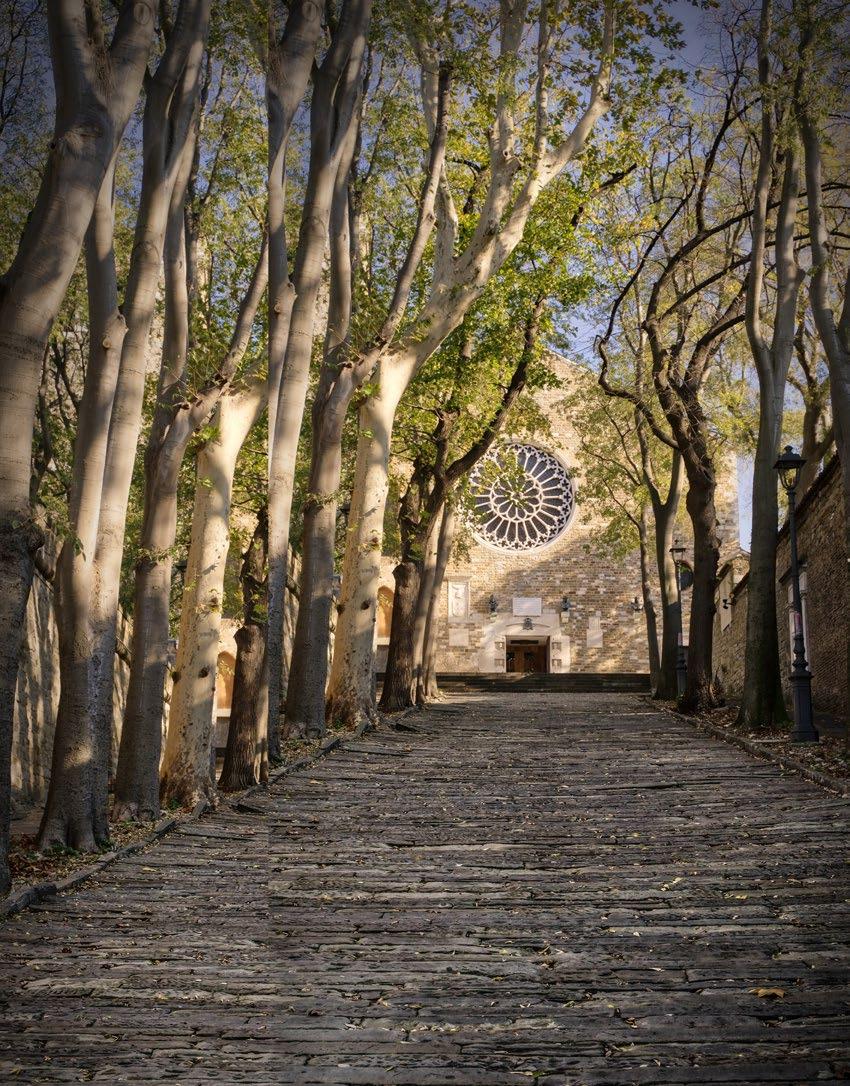
TRIESTE LIFESTYLE N° 7 Walking Literature A Wind called Bora San Giusto Fashion City No border Food SEPTEMBER 2019
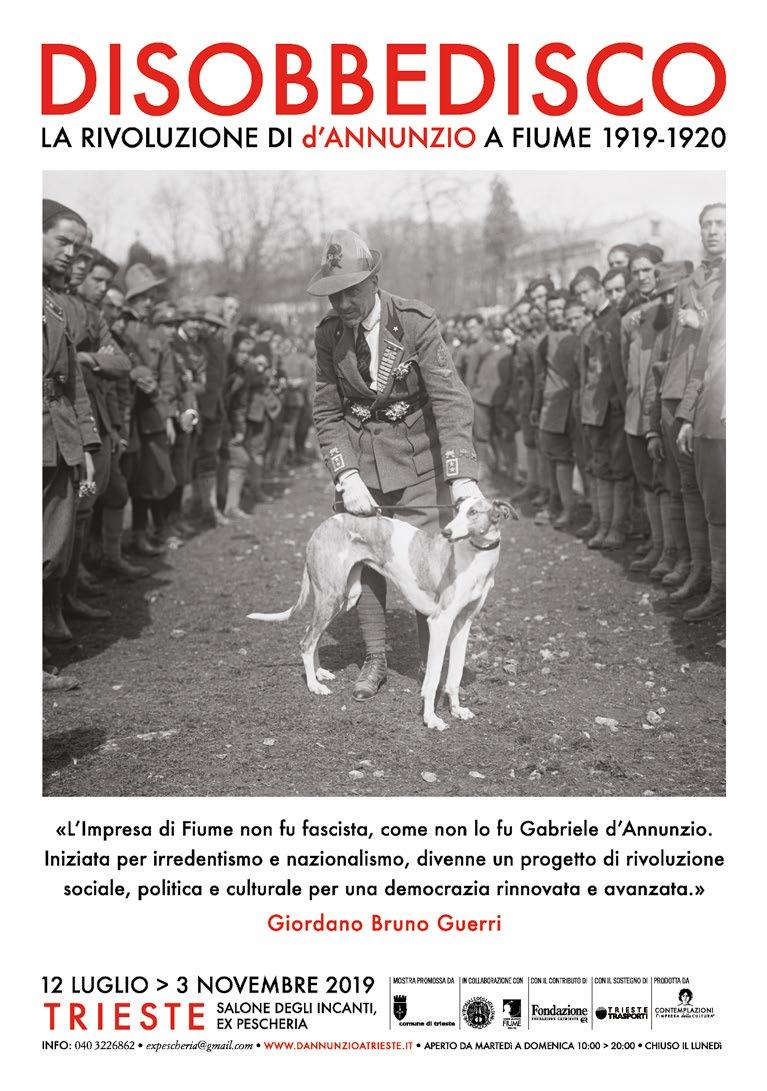
Camminare è un processo creativo. E lo è ancor di più in una città che si candida a far parte del network delle “città creative” dell’UNESCO per la Letteratura. Perchè camminare a Trieste, fra le viuzze di Cavana, la luce di Barcola, la via Capitolina, il fascino di San Giusto, i viottoli del Carso o all’ombra del Faro, significa “portare a spasso la mente”, fra storia, porto, commerci, assicurazioni, finanza e grandi navi, ma anche natura, cultura e letteratura. Camminare è creativo perchè ci porta in mezzo a suggestioni e racconti che non abbiamo più tempo di vivere e ascoltare. È creativo perchè si cammina “non per affermare il proprio io, ma per dimenticarlo”, come dice Luigi Nacci parlando della viandanza. E camminare è creativo finanche se lo si fa idealmente, in uno dei teatri della città o fra i cibi “senza confini” di tradizioni da sempre vicine e lontane, che s’incontrano e scontrano nell’eterno alternarsi di un passo che è sempre il prima e il dopo di ogni istante. —
Walking is a creative process. And this is particularly true for a city applying to become a ‘City of Literature’ within the UNESCO Creative Cities Network. Because strolling around Trieste, through the narrow streets of Cavana, under the sunshine in Barcola, in the charming atmosphere of via Capitolina and San Giusto, the roads on the Karst or in the shade of the Lighthouse, means “taking your mind for a walk”, through history, the port, commerce, insurance, finance and large ships, but also nature, culture and literature. And walking is creative also when you do it ideally, in one of the theatres of the city or tasting “food without borders” consisting of nearby and far away traditions, that meet and clash in the eternal alternating of a step that takes place always before or after every instant.
Alfonso Di Leva
Ies Magazine Trieste Lifestyle
N° 7 – September 2019
direttore responsabile
Alfonso Di Leva
supervisione editoriale
Giovanni Marzini
hanno collaborato
Alice Fabi, Isabella Franco, Micol Brusaferro, Nicolò
Giraldi, Rino Lombardi, Ilaria
Lucari, Ilaria Romanzin
traduzioni
Rita Pecorari Novak, Eugenia
Dal Fovo, Rebecca Blakey
progetto grafico
Matteo Bartoli – Basiq
illustrazione
Jan Sedmak
progetto editoriale
Prandi Comunicazione & Marketing
segreteria di redazione
Fabiana Parenzan
redazione@prandicom.it
fotografie
Cesare Bellafronte, Anja Čop, Ulderica Da Pozzo, Fabrice
Gallina, Massimo Goina, Marino
Ierman, Comune di Trieste
– Fototeca dei Civici Musei di Storia ed Arte, Archivio
Promoturismo FVG, Archivio
Adobe Stock
stampa
Riccigraf – Trieste
CITTÀ DA SCOPRIRE DISCOVER THE CITY Walking & life 2 di Nicolò Giraldi 9 Walking Paths 8 Gli angoli della Bora 18 di Rino Lombardi Shop Spazio Cavana 22 Walking in Literature 24 PORTFOLIO Il Castello di San Giusto 28 di Marino Ierman Comune di Trieste, Fototeca dei Civici Musei di Storia ed Arte CITTÀ DA VIVERE LIVE THE CITY Paolo Condò: 38 vedi Trieste e poi muori! di Giovanni Marzini FVG World 42 di Isabella Franco Hands on Science 44 di Ilaria Romanzin La città della moda 48 di Micol Brusaferro Rossetti Theater 52 di Ilaria Lucari Film & Festival 56 di CITTÀ DA GUSTARE TASTE THE CITY Dishes & Rooms Al Petes + Casa 903 60 Wine tourism 62 Collio Russiz superiore 64 No border Food 65 di Alice Fabi Top Five 68 AGENDA Benessere esclusivo 71 Barcolana 50+1 72 Fuori Porta Beethoven a Muggia 74 Grado & Lignano Challenge 76 Post-it Hop Tour 78 Agenda 79
N° 7 Autorizzazione del Tribunale di Trieste del 16 marzo 2018, numero periodico 9/2018 V.G. 847/2018.
TRIESTE LIFESTYLE IES N°7 — September 2019 Sommario

2 TRIESTE LIFESTYLE IES N°7 — September 2019 Città da scoprire
WALKING & LIFE
Trieste è una città noiosa, vivere qui non mi fa né caldo né freddo”. La citazione proviene dall’ultimo libro del poeta e viandante Luigi Nacci dal titolo Trieste selvatica, volume che è rimasto in vetta alle classifiche di vendita per settimane e che è diventato un vero e proprio caso editoriale.

Nacci da anni cammina lungo le tracce che compongono il reticolato dei passi di casa nostra, le voragini dove rimangono nascoste le storie che non abbiamo più tempo di ascoltare, chissà perché, chissà come.
Le tracce sono le stesse che Luigi lascia: per parlare a chi arriva da fuori,
per raccontare che in fondo, il confine orientale d’Italia non è fatto solamente di salotti buoni e caffè gustosi, fumoir affascinanti o chiese profumate, “preda” del turismo facile. No, questa terra è soprattutto di chi va a piedi e di chi trova il tempo per ascoltare le storie delle nostre terre.
Cos’è la viandanza per te?
La viandanza è la possibilità di un’altra vita, dove la parte nomade e quella sedentaria che sono in noi convivono senza prevalere l’una sull’altra. Va oltre il camminare, che è un’attività innanzitutto fisica, e oltre il cammino, che è un viaggio all’ennesima potenza.
Nel tuo ultimo libro Trieste selvatica, buona parte delle pagine rivolgono lo sguardo ai boschi, alle
3 TRIESTE LIFESTYLE IES N°7 — September 2019 Discover the city
di /by Nicolò Giraldi
foreste, e alle storie dimenticate delle terre orientali. Andarci a piedi può essere rimedio alla volontà politica di erigere nuove barriere? Se sì, con quali conseguenze?
Chi va a piedi è una creatura indifesa. Non è il soldato che marcia, va senza protezioni, non per affermare il proprio io ma per dimenticarlo. Noi di guerre in queste terre ne abbiamo avute anche troppe. Procedere lenti con una bandiera bianca issata sullo zaino non è la soluzione a tutti i mali, ma di certo non incrementa i rancori, né alimenta l’odio come alcuni hanno ancora in animo di fare. La seconda metà dell’800 e il ’900 sono stati tragici da queste parti, a causa dei nazionalismi. Il viandante non può essere nazionalista perché non ha un io da difendere, e quando vede un muro lo scavalca, non sa né può fare altro.
Trieste da girare a piedi, perdersi nelle vie. Se è vero che i turisti la vivono solo nei luoghi simbolo, dove è rimasta l’autenticità triestina al di fuori dei salotti buoni?

La grande Trieste, quella del porto imperiale e degli scrittori antesignani, è stata la città del caos. Senza quel caos di genti, lingue, sogni e popolo, non sarebbe forse stato possibile il genio di uno come Joyce. Oggi c’è il Carso, e poco più in là la selva, dove la natura fa il suo corso e nulla può essere facilmente addomesticato. A chi viene da fuori consiglio di lasciare il centro e perdersi nei boschi che ci circondano, essere un po’ meno turista e più esploratore.
Per quale motivo si può essere in cammino anche senza camminare?
Perché è lo spirito a contare. Il cammino ti fa vedere molte cose: quanto sei piccolo rispetto a una quercia secolare, o fragile rispetto a un possente animale selvatico, capace di sforzi immani, di cavartela da solo, e allo stesso tempo quanto hai bisogno dell’aiuto altrui, perché non trovi la strada o ti sei fatto male. Soprattutto ti incita a fidarti, a bussare alle porte, chiedere dell’acqua, ospitalità. Sono attitudini che, riportate
nella nostra vita quotidiana, ci migliorano come esseri umani.
Cosa non ti piace dell’aumento del flusso turistico a Trieste e provincia e cosa manca nell’approccio alla materia?
Il ragionamento è complesso. Per dirla in breve direi che abbiamo due strade: quella che porta al modello Venezia, con una città-cartolina che preferisce i turisti ai suoi cittadini, e una strada nuova, da costruire tutti assieme, dove centro, periferie, Carso e dintorni sono equiparati, la rete e il sistema prevalgono sul fermo immagine. Trieste deve ricordarsi di essere il punto di riferimento di un’area più vasta, non un’area metropolitana, ma “silvano-metropolitana”, plurilinguistica e multiculturale: Castello di Miramare e castellieri carsici, piazza Unità e foci del Timavo, le statue di Saba e Svevo insieme alle grotte di Slataper e ai pini di Kosovel, i caffè storici con le foreste piene di orsi. E non deve scordare il suo lato popolare: le osterie devono rimanere osterie, le osmize devono rimanere osmize, non trasformarsi in locali gourmet. Siamo stati grandi quando siamo stati una mescolanza, la nostra forza, diremmo in dialetto, è nel mis mas
.
Chi va a piedi è una creatura indifesa, va senza protezioni, non per affermare il proprio io ma per dimenticarlo. –
4 TRIESTE LIFESTYLE IES N°7 — September 2019 Città da scoprire
A walking traveller is a harmless and defenseless creature, on a journey to forget their own ego.
ENGLISH TEXT
Trieste is a boring city, living here is quite underwhelming”. This is a quote from “Trieste selvatica” [Wild Trieste, N/T], the latest work by poet and wayfarer Luigi Nacci. The book has dominated the top selling charts for weeks and is now considered a publishing sensation.
For years Nacci has been walking the trails made of footprints outlining our homeland, flanking the deep craters that hide long-forgotten stories, stories we have no longer times to listen to who knows why, who knows how.
By doing so, Luigi leaves footprints of his own, which speak to those who come from the outside, telling them that, after all, Italy’s eastern-most border is not only about exclusive high society lounges and delicious coffee, fancy smoking rooms and scented churches easy targets of mass tourism. No, this is a place that is first and foremost home to those who travel by foot and find time to listen to the stories of our lands.
What is wayfaring to you?
Wayfaring is the possibility of a different life, where our nomadic spirit and our sedentary side coexist in harmony, without trying to prevail over one another. It is more than walking, which is mostly physical activity, and it is more than a pilgrimage, which represents the ultimate travelling experience.
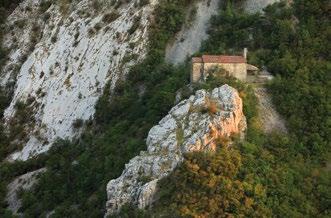
A large part of your book “Trieste selvatica” takes the reader on a journey through woods, forests, and forgotten stories of these Eastern lands. Could a journey on foot somehow trigger a counter-trend with respect to those in politics who would like to see new barriers built here? And if this is the case, what would the consequences be?
Unlike a marching soldier, a walking traveller is a harmless and defenseless creature, on a journey to forget their own ego, rather than asserting it. These lands have seen many wars, too many wars. True walking with a white flag flapping on your backpack is hardly a universal remedy, but it certainly does not stir up rancour, or feed hatred like some people are still doing. From the second half of the 19th century to the end of the 20th century any type of nationalism has brought only tragedy
Luigi Nacci è poeta e scrittore. Dopo alcuni volumi di versi ha pubblicato in prosa Alzati e cammina (Ediciclo 2014, Premio L’Albatros-Città di Palestrina per la letteratura di viaggio) e Viandanza. Il cammino come educazione sentimentale (Laterza 2016). Per Ediciclo dirige la collana “La biblioteca del viandante”. Si occupa da molti anni di Trieste, del Carso e delle terre che li circondano. Lo fa nelle biblioteche e sui sentieri, camminando da solo e in gruppo. La “viandanza”, parola che ha messo al centro della sua ricerca di uomo e autore, è per lui un modo di tenere insieme la parte sedentaria e quella nomade.
Luigi Nacci is an Italian poet and writer. After a number of poem collections, in 2014 he released his first prose volume “Alzati e cammina” (published by Ediciclo), which won L’Albatros-Città di Palestrina award for travel literature, and was followed in 2016 by a second volume, “Viandanza. Il cammino come educazione sentimentale” (published by Laterza). He is currently editor of Ediciclo’s Series “La biblioteca del viandante”. For many years he has been writing about Trieste, the Karst, and the surrounding areas. He writes in libraries and on the go, alone or in a group. Wayfaring, centre of his quest for human and scientific research, is his way of bringing together man’s nomadic nature and sedentary disposition.

5 TRIESTE LIFESTYLE IES N°7 — September 2019 Discover the city
upon this part of the world. Wayfarers could never endorse nationalism because they have no ego to fight for, and when they meet a wall they climb over it they do not know any better, nor could they learn to do otherwise.
Walking through Trieste, letting oneself get lost in its streets. If it is true that tourists seem to privilege the city’s most symbolic sites, is there any authenticity left outside society’s elite circles?
The great Trieste, Imperial free port and city of literature’s great names that Trieste was a city of chaos. Only a chaotic mixture of peoples, languages, dreams, and cultures could nurture such geniuses as Joyce. Today there is still the Karst, and, beyond it, the wild, where nature rules over an almost untamable kingdom. My advice to visitors is to ignore the centre and get lost in the woods surrounding it, not so much as tourists, but rather as explorers.
How can one be walking a path without actually walking?
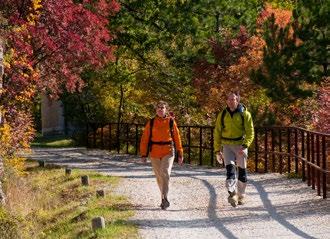
It is one’s spirit that counts. The path can show you many things: how small you are compared to a centuries-old oak tree, or how fragile compared to
a mighty wild predator; but also how your body can survive unthinkable efforts so that you can manage on your own; and, at the same time, how much you need the help of others, when you lose your way or you get hurt. That is what encourages you to give trust, knock on doors, ask for water, seek asylum. When translated into everyday life, this attitude makes us better human beings.
Is there anything you dislike about Trieste’s increasing tourists’ flow, and what would you say is the main flaw in the current approach to this subject?
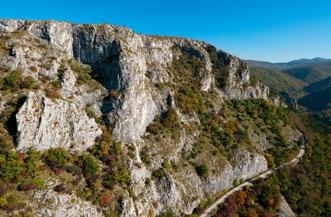
The reasoning is complex. In short, I would say that two options lay ahead: on the one hand, there is the Venice model, a postcard city that chooses her tourists rather than her own citizens;
or a new model, one we build all together, with centre, suburbs, Karst, and surroundings on the same level, so that the city’s network and system prevail over the postcard. Trieste needs to remember her pivotal role beyond the urban area, her dimension of “sylvan metropolis”, a city of many languages and many cultures: the Castle of Miramare and the Karst Castles; Piazza Unità d’Italia and the Timav’s mouths; Saba and Svevo’s statues together with Slataper’s caves and Kosovel’s pine trees; historical cafés and forests where bears dwell. And she has to remember her people’s side: inns must be inns, osmize must be osmize, never giving in to the gourmet trend. We are great only when we are a mix or, in the local dialect, our strength is in the mis mas [mishmash, N/T].
–
Il cammino ti fa vedere molte cose: quanto sei piccolo rispetto a una quercia secolare, o fragile rispetto a un possente animale selvatico.
6 TRIESTE LIFESTYLE IES N°7 — September 2019 Città da scoprire
The path can show you many things: how small you are compared to a centuries-old oak tree, or how fragile compared to a mighty wild predator.
la cultura,
Leggere un libro. Visitare una mostra. Ascoltare un concerto. Raramente si pensa che si tratta di autentici “privilegi”: oggi condivisi da molti, ma ancora (anche se può apparire strano) preclusi ai più.
La cultura, per progredire, richiede continue “chiavi di accesso”. Dalle più elementari (come il saper leggere) ad altre più sofisticate, che la cultura stessa, quasi per “geminazione”, crea di continuo.
Chiavi che ci consentono di scrutare orizzonti sempre più affascinanti e impegnativi (percepire l’enigma di una statua greca, di un quadro astratto o di un brano musicale, al di là della mera contemplazione).
Chiavi che durano per sempre. Che affinano gusto e capacità di giudizio. Che non possiamo smarrire e che nessuno ci potrà mai rubare. Che potremo condividere e scambiare con altri.
La cultura, innegabile segno di benessere sociale. Ma anche matrice di autentica felicità individuale.
Trieste ospiterà nel 2020 ESOF (Euroscience Open Forum), il più grande e importante evento europeo dedicato alla ricerca e all’innovazione, in una prospettiva multidisciplinare che coinvolge scienza, impresa e società.
La manifestazione sarà uno degli eventi più significativi della storia recente di Trieste anche per la valorizzazione e la riqualificazione del territorio, a cominciare da una vasta area del Porto Vecchio che ospiterà una parte importante della rassegna.
A questo appuntamento non poteva mancare la Fondazione CRTrieste, che da sempre sostiene lo sviluppo del proprio territorio.

il colore del benessere sociale
quasi un processo di “geminazione”
9 WALKING PATHS

8 TRIESTE LIFESTYLE IES N°7 — September 2019 Città da scoprire
Per tutti
I triestini chiamano questo viale, autentica arteria pedonale, con il nome di acquedoto in virtù della presenza sotterranea della rete di approvvigionamento idrico voluta dall’imperatrice Maria Teresa nella seconda metà del ‘700. Partendo da largo don Bonifacio nei pressi dei portici di Chiozza, si muovono i passi attraversando una zona che negli anni Sessanta veniva percorsa avanti e indietro dai triestini, in quelle che, mutuando l’affermazione dal nuoto, vengono definite “vasche”. Inoltre, lungo il viale ci si può imbattere in alcune osterie che mantengono ancora oggi il loro carattere autentico. Nei pressi dell’estremità nord, si trova il palazzo dove nacque una delle birre più famose al mondo, la Dreher. L’antico stabilimento oggi è sede dell’Agenzia delle Entrate.
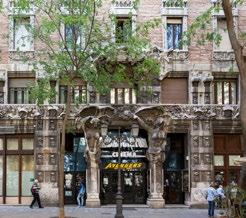
IN THE CITY
For all
Locals call this pedestrian lane acquedoto [aqueduct, N/T], because it runs right above the water-main network that Empress Maria Theresa had built underneath the city ground in the second half of the 18th century. Starting from Largo Don Bonifacio, right next to the arcade called “Volti di Chiozza”, one enters an area that used to be Trieste’s pedestrian city centre in the Sixties, when Triestini would take many a leisure stroll walking up and down this series of parallel streets, called “vasche” [i.e. swimming pool lengths, N/T]. Here and there along the main boulevard you can still find a number of osterie, traditional taverns that still preserve their authentic character. Heading North, you will eventually reach the building where world-renowned Dreher beer was born, and hosting today one of the offices of Agenzia delle Entrate [Italian Revenue Agency, N/T].
1 1 2
3 Barcola
Miramare Conconello
Grignano Contovello
Prosecco Gretta
Via di Cologna
9 TRIESTE LIFESTYLE IES N°7 — September 2019 Discover the city
Viale XX Settembre
Per chi ha buone gambe
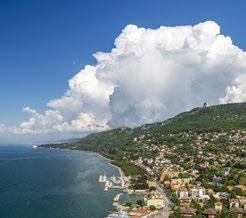
Una passeggiata vicino al mare, lungo la riviera di Barcola dove far scomparire i pensieri legati al quotidiano. Partendo da piazzale 11 settembre e seguendo la linea di costa in circa un’oretta si giunge al castello di Miramare, passando il Cedas, lo stabilimento gratuito chiamato “Topolini” e la Marinella. Ma al di là della splendida conclusione con il bianco maniero, un’attenzione particolare merita la pineta di Barcola, piantata dopo la Seconda Guerra Mondiale e che i triestini deridevano con l’inconfondibile autoironia locale. Oggi questo bosco sul mare offre alcuni locali tipici, un po’ d’ombra durante la canicola estiva per picnic di gruppi di giovani e famigliole e un’area da percorrere in lungo e in largo, lasciandosi alle spalle le fatiche del giorno.
For skilled walkers
A walk along the waterfront, on Barcola’s riviera, is all you need to forget all about the trials and tribulations of everyday life. Starting from the square Piazzale 11 Settembre a one-hour walk along the coast line leads you through Cedas marina, Topolini free bathing establishment and La Marinella seafood restaurant, all the way to Miramare Castle. The manor’s pure white walls are the perfect grand finale of this itinerary, but on your way there you may want to linger in the cool shade of La Pineta, Barcola’s pine grove planted after World War II much to the amusement of Triestini, who used to smirk at the sight of those tiny trees, true to the jabbering nature of local peoples. Today this pine grove on the sea line is populated with traditional taverns, many shaded spots perfect for a family picnic or a cold drink with friends on a hot summer day, and a network of walk paths where you can shake off the stress at the end of a working day.
Per chi ha fiato e gambe
Partite dal piazzale poco prima dell’abitato di Ferlugi/ Conconello e seguite il sentiero che conduce allo stagno. Dopo poco, sulla destra troverete un’antica traccia in discesa da percorrere interamente fino all’intersezione con strada nuova per Opicina. Prendete via dei Baiardi, che si trova dall’altro lato della strada, e girate immediatamente a sinistra lungo via Clivo Artemisio. Dopo circa 300 metri, dopo aver oltrepassato un ponte della vecchia linea ferroviaria che portava a Vienna, girate a destra lungo via Fleming e spingetevi fino in fondo alla strada. Alla fine, girate ancora a destra lungo una vecchia mulattiera abbandonata ma percorribile. Sbucherete in salita monte Valerio e, in conclusione in via Cologna. L’itinerario fa parte degli antichi sentieri che le donne slovene del Carso percorrevano a piedi per portare il latte (mleko in sloveno) alle famiglie borghesi della Trieste che fu. Insomma, la via delle mlekarice, le donne del latte.
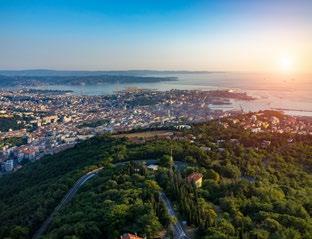
For expert walkers
Starting from the little square in front of the residential area of Ferlugi/Conconello, follow the path leading to the pond. Ahead, on your right, you will see an old track running downhill all the way to the crossroad intersecting Strada Nuova per Opicina. Here cross the road and take Via dei Baiardi, immediately turning left into Via Clivo Artemisio. Proceed for approximately 300 metres, crossing the bridge over the old railroad that used to connect Trieste to Vienna, and then turn right into Via Fleming. At the end of the road, on your right, an old mule track, now abandoned but still in good condition, leads to Salita Monte Valerio, eventually reaching Via Cologna. This itinerary was once trodden by Slovene women, who used to come down the Karst to bring milk (Slovenian: mleko) to the gentry families of Trieste hence its colloquial name Via delle Mlekarice, the road of the milk women.
2 3 10 TRIESTE LIFESTYLE IES N°7 — September 2019 Città da scoprire
IN THE OUTSKIRTS
Per chi ha fiato e gambe
Dalla birra Dreher all’antico borgo di Cattinara. Esiste un bosco immerso nella città di Trieste che si chiama Cacciatore, ma che per tutti i triestini sarà solo ed esclusivamente “el boschetto”. Proprio dietro la vecchia fabbrica della Dreher inizia un dedalo di sentieri che conduce in direzione dell’abitato di Cattinara, che prima dell’edificazione del principale ospedale triestino, manteneva le caratteristiche rurali di un piccolo borgo. La bellezza di questo itinerario sta un po’ nel perdersi lungo i sentieri, senza mai perdere di vista Cattinara. A pochi passi dall’ospedale si trova infatti uno dei cimiteri più antichi di Trieste, dove hanno diritto a essere seppelliti solamente i residenti dei rioni di Cattinara e Longera. Gironzolare tra le lapidi può restituire l’immagine di una Trieste diversa, vista l’alta concentrazione di cognomi sloveni presenti all’interno di questo piccolo camposanto.
For expert walkers
From Dreher beer to the old village of Cattinara. In the heart of Trieste grows a forest called Cacciatore [Hunter, N/T], but known among the Triestini simply as “el boschetto” [the little wood, N/T]. Behind Dreher’s old factory a maze of pathways unfolds in the direction of Cattinara’s residential area, which used to resemble all the other little villages, or borghi, surrounding the city, until Trieste’s main hospital was built here. The beauty of following this itinerary is letting oneself get lost in the maze, keeping Cattinara hospital as your only reference point. Next to the hospital one of Trieste’s oldest cemeteries hosts only the remains of those who have lived in the districts of Cattinara and Longera. The many Slovenian family names that populate the gravestones of this little graveyard tell the story of a different Trieste.
5 6 4 4
San Giacomo
Bagnoli della Rosandra
Longera Barcola Servola Servola
Cimitero di Cattinara Boschetto
Padriciano
Obelisco
Borgo Grotta Gigante
Monte Grisa
Opicina Prosecco 11 TRIESTE LIFESTYLE IES N°7 — September 2019 Discover the city
Borgo San Nazario
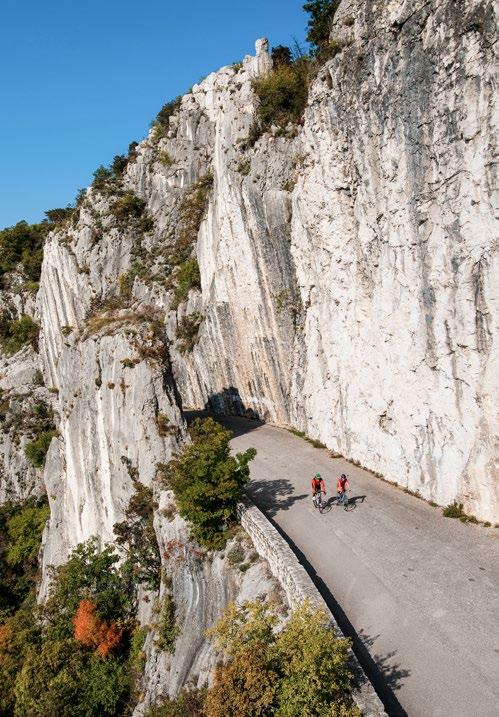
12 TRIESTE LIFESTYLE IES N°7 — September 2019 Città da scoprire
Per tutti
Dal piazzale dell’obelisco a Opicina muovetevi in direzione del santuario di monte Grisa e dell’abitato di San Nazario. Il sentiero è di una facilità estrema ed è luogo particolarmente amato dai triestini, anche per la leggenda ispirata a un improbabile passaggio napoleonico, quando le truppe del Corso occuparono Trieste alla fine del Settecento. Al di là della narrazione, alcuni scorci regalano panorami mozzafiato, come d’altronde la presenza di un bosco fitto che protegge dall’inquietudine quotidiana. Una volta giunti sotto le falesie carsiche potrete incrociare giovani che arrampicano e, una volta in paese, fermatevi nella prima osteria che trovate sulla destra, gestita da una famiglia di profughi istriani dove si conserva ancora il ricordo di un Carso particolare. Borgo San Nazario è infatti uno dei tanti borghi costruiti appositamente per dare ospitalità agli istriani, giunti a Trieste nel Secondo Dopoguerra.

For all
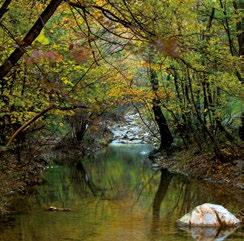
From Opicina obelisk square head towards the Sanctuary of Monte Grisa and the residential area of San Nazario. It is an easy-level walk and one of Triestini’s favourite places, perhaps also because of a legend claiming that Napoleon passed through here, when his troops occupied Trieste at the end of the 18th century. Facts and fantasies aside, this itinerary surely offers some breathtaking glimpses of the surrounding landscapes where the vegetation thins out everywhere else the trees grow high and thick, forming an impenetrable wall that guards this place from the humdrum routine of city life. Once you reach the cliffs of the Karst Plateau, habitual destination of rock climbers, continue to the village of Borgo San Nazario, and enjoy a restorative stop at the first osteria you see on your right: the tavern is run by a family of Istrian refugees, whose recipes still preserve the charm of the Karst as it used to be. Indeed, Borgo San Nazario is one of the many Karst towns built to provide shelter to Istrian refugees, who fled to Trieste in the aftermath of World War II.
Per chi ha buone gambe
Campo San Giacomo, la piazza principale di uno dei rioni più popolosi di tutta la città. È da qui che si possono infilare gli scarponi e dirigersi verso la pista ciclopedonale che conduce fino alla zona della val Rosandra. È a tutti gli effetti una passeggiata semplice, non tremendamente impegnativa, che si può interrompere in qualsiasi momento ma che è in grado di regalare una bretella tra l’area urbana e quella della periferia naturale. Si passa dal colorato caos di San Giacomo, rione preferito dalla storica comunità serba della città, al silenzio del bosco, interrotto solamente dal rumore di qualche bicicletta o di invisibili passeriformi. Un itinerario per chi ama sovrapporre le storie, e legare le diverse identità di Trieste, o di Trst, che dir si voglia.
For skilled walkers
Campo San Giacomo is the name of the main square of one of Trieste’s most densely populated rioni [districts N/T]. Lace your walking shoes and head to the pedestrian and bike path that runs into Val Rosandra. This fairly easy walk connects the city to its natural backyard, offering numerous resting areas along the way. Leaving behind the colourful chaos of San Giacomo, you will soon be entering the soothing silence of the woods, interrupted here and there by the sound of a bicycle’s wheels or the call of a sparrow. An itinerary to discover the many layers of this land’s history and draw a line connecting the many identities of Trieste, or Trst, depending on the name you prefer.
6
5 13 TRIESTE LIFESTYLE IES N°7 — September 2019 Discover the city
IN THE LANDSCAPE
Per tutti
Le piante aromatiche del Carso a volte danno il nome ad antiche tracce utilizzate per secoli. È questo il caso della salvia che diventa protagonista di uno dei sentieri più suggestivi di tutta la provincia di Trieste. Dall’abitato sloveno di Santa Croce si snoda un itinerario poco faticoso ma di una bellezza disarmante, a picco sul mare dove i pescatori, fino a qualche decennio fa, erano soliti riunirsi per la pesca del tonno. La traccia, dalla quale un tempo avremmo potuto ammirare l’ebollizione del golfo al passaggio dei grandi banchi pelagici –”el mar che boi” direbbero i tržačani, i triestini di lingua slovena– conduce all’abitato di Aurisina, dopo circa un’ora di passi circondati dalla salvia, dall’elicriso, dal timo e da quel particolare profumo simile al caffè che l’euforbia produce.
For all
There are old trails on the Karst Plateau named after the herbs that grow on their sides. Sage, for instance, is the name of one of the most beautiful trails of Trieste and its surroundings. From the Slovene enclave of Santa Croce an easy walk leads you to a cliff side that dives into the sea, in a landscape of disarming beauty, where a few decades ago fishermen used to gather for tuna fishing. Once you could see the Gulf waters churning from here, as schools of large pelagic fish made their way to the coast “el mar che boi” [the sea that boils, N/T] as Tržačani [Slovenian-speaking Triestini] would say. The trail leads to the town of Aurisina, a one-hour walk surrounded by sage, red everlasting, thyme, and that coffee-like distinct scent of spurge.
8 7 7 9
Ceroglie Sistiana
Monte Hermada
Padriciano
Foiba di Basovizza
Santa Croce
Val Rosandra
Trieste Koper Škofije
San Giacomo
Molo Audace
Aurisina
14 TRIESTE LIFESTYLE IES N°7 — September 2019 Città da scoprire
Muggia
Per chi ha buone gambe
Sulla cima del monte Hermada, ai confini settentrionali della provincia di Trieste, non c’è traccia di memoria. Questa altura di 323 metri sul livello del mare rappresentò infatti la roccaforte difensiva per le truppe austroungariche durante il primo conflitto mondiale e, ad oggi, poche sono le persone che si interessano di questo pezzo dimenticato dalla storia ufficiale, quella scritta come sempre dai vincitori. La cima di questa collina si può raggiungere da diverse località. Da Malchina si può prendere il sentiero che si trova nella parte nord dell’abitato e da qui seguire una lunga traccia che conduce fino all’intersezione con la strada bianca proveniente da Ceroglie. Da questo bivio si inizia a salire fino a toccare con mano la prima linea del fronte del Carso. Fritz Weber, ufficiale austroungarico che pubblicò le sue memorie in Tappe della disfatta, dedicò all’Ermada –si può scrivere anche così, oppure Grmada, non fa differenza– alcune pagine del racconto degli anni passati in guerra. Una narrazione che riporta ad un periodo, per tutta questa zona, terrificante.
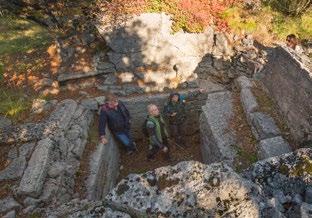

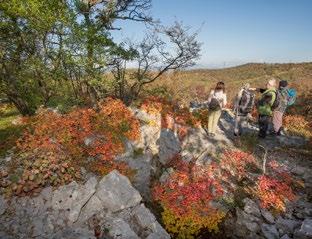
For skilled walkers
On the top of Monte Hermada –also known as Ermada and Grmada– one of the hills in the northern part of Trieste’s province, there is no memory. Here, at 323 metres above sea levels, Austro-Hungarian troops built their defensive stronghold during World War I. Today, few care about this fragment of history, a feeble voice, drowned by the fanfare of the winners. The hilltop can be reached through various routes: from the little farmers’ village of Malchina, for instance, a path running northward leads to a crossroad with a dirt track coming down from the village of Ceroglie. Heading uphill from here, the trail leads to the first line of the Karst front. AustroHungarian army official Fritz Weber, whose memoires were published in the book Das Ende der alten Armee [The end of the old army, N/T], writes about Mount Hermada in his account of the war a chilling testimony of the tragic years that these lands went through.
8
15 TRIESTE LIFESTYLE IES N°7 — September 2019 Discover the city
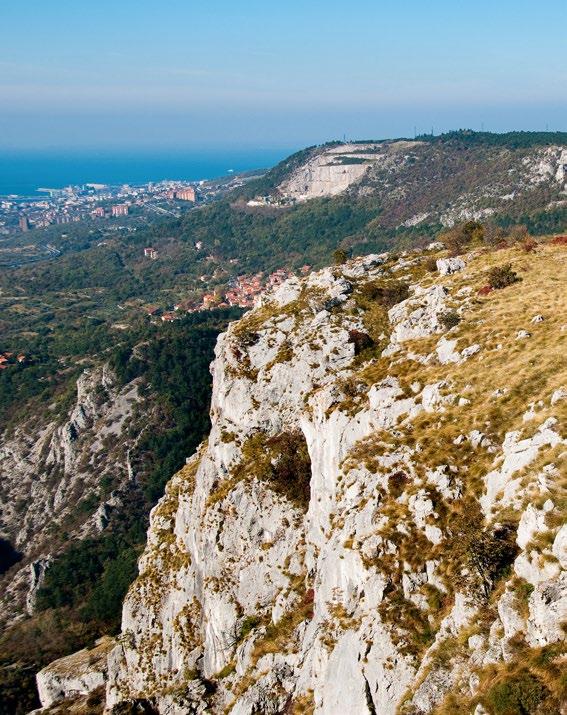
16 TRIESTE LIFESTYLE IES N°7 — September 2019 Città da scoprire
Per chi ha fiato e gambe
Nel riassunto dei cammini orientali, emerge con forza la cinque giorni organizzata dalla Compagnia dei Cammini che, grazie alle parole e ai passi di Luigi Nacci, organizza il periplo del Carso. Si parte da molo Audace –già molo San Carlo–e si penetra all’interno del ventre di Trieste, mescolandosi tra i serbi del rione di San Giacomo, puntando dritti verso la val Rosandra –o Glinščica–e poi via verso i drammi del Novecento. La foiba di Basovizza, il campo profughi di Padriciano, la Prima e la Seconda Guerra Mondiale, le occupazioni e i tormenti di una città strana, difficile e per certi versi indomabile. Si cammina sottoterra, tra grotte, cavità e cunicoli, si ascoltano ospiti che parlano il dialetto, si immaginano silenzi e si rispettano le espressioni sonore a noi poco familiari. Sono cinque giorni in grado in regalare agli occhi una scintillante curiosità nei confronti di una terra divisa, dove le ferite del tempo si stanno lentamente rimarginando; un centinaio di chilometri per avvicinarsi alla comprensione di qualche centinaio di anni. Dovrebbero essere sufficienti, soprattutto per chi qui arriva con lo sguardo del viaggiatore.
For expert walkers
One of the most impressive Eastern Trails in this area is the five-day trail circumnavigating the Karst Plateau, organised by the association Compagnia dei Cammini, especially thanks to one of its members, wayfarer and writer Luigi Nacci. Starting from Molo Audace (formerly known as Molo San Carlo) the trail enters the very heart of the city centre, through the Serbian neighbourhood of rione San Giacomo, leading towards the mouth of Val Rosandra (or Glinščica) and the memories of the 20th century horrors. Basovizza Foiba, Padriciano’s refugee camp, World Wars I and II, and the occupation and torments of a strange, difficult, somehow indomitable city. The trail here dives underground, through caves, sinkholes, and tunnels, and along the way visitors are told the stories of these places by their dialect-speaking hosts, while imagining their silence, and respectfully listening to unfamiliar sounds and expressions. Five days that kindle a genuine interest in these divided lands, where past wounds are slowly healing. One hundred kilometres that shed some light on a turbulent century. It should be enough, at least for those who come here with a traveller’s spirit.

9
17 TRIESTE LIFESTYLE IES N°7 — September 2019 Discover the city
Dell’andare controvento nella città della bora —
On wandering upwind in the city of the Bora
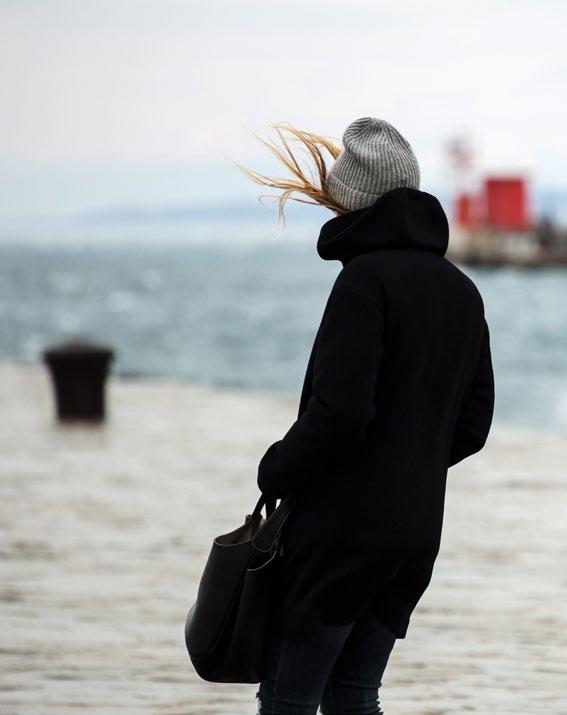
GLI ANGOLI DELLA BORA
18 TRIESTE LIFESTYLE IES N°7 — September 2019 Città da scoprire
Ognuno ha il suo modo di vivere la bora: più giocoso, più spensierato, più spregiudicato o più prudente. E non è detto che all’alzarsi dell’età anagrafica corrisponda un aumento della prudenza. A proposito di bora, Mauro Covacich ci dà qualche suggerimento nel suo Trieste Sottosopra . Per lo scrittore triestino, che dedica un capitolo alla bora nel rione di San Luigi, si può scendere a rotta di collo con le ali aperte giù per la via de Marchesetti.
Oppure “Si può stare fermi, resistere contro vento, senza spostare i piedi. Inutile dirvi che il divertimento è assicurato: i più leggeri di voi rischieranno non proprio di volare, ma di perdere contatto con la terra bè, questo sì.”
Aggiungo che a Trieste avete l’imbarazzo della scelta quanto a discese!
Solitamente nelle vie che scorrono tra le case più antiche trovate anche dei provvidenziali corrimano… Un altro scrittore triestino, Stelio Mattioni, mai ricordato abbastanza, elaborò una serie di consigli per affrontare la bora, compreso il seguente: “Se il rèfolo attacca di fronte, afferrarsi a qualcosa e piegarsi pure indietro perché, non appena quello molla di colpo, ci si trova inclinati in avanti come quando a cavallo si è saltato un ostacolo, ma sempre in sella!”

Quando il vento ti spinge alle spalle ti senti come un calciatorino del Subbuteo: pensi di essere tu il padrone del gioco, ma in realtà c’è una
grande mano che ti porta dove vuole lei. Perché restare passivi davanti a questo fenomeno naturale? Suvvia, affrontiamolo a testa alta! O almeno, proviamoci. A testa bassa!
Ci sono punti ideali in città per farlo. Piazza Unità lato Palazzo della Regione (ex Lloyd Triestino). C’è da fare attenzione però, meglio essere a metà della piazza che verso il mare… Proprio lì, prima di tuffarsi nel bacino di San Giusto, la bora ha ribaltato mezzi piuttosto pesanti, come un tram, un tir turco, furgoni, oltre a motocarrozzette, moto e scooter in quantità.
Più indicato per una prova è l’angolo tra via San Nicolò e via Dante per raggiungere piazza della Repubblica. Lì si può provare una speciale ebbrezza nel dominare il vento, in una sorta di palestra en plein air, dopo aver reso omaggio alla statua di Umberto Saba. Siamo o non siamo una città letteraria?
Dopo avere camminato controvento nella bora, senti di poter fare tutto.
La bora ti carica. Hai le energie per affrontare una stressante giornata di lavoro, per vincere qualche resistenza interiore o per prendere una decisione importante. O almeno, io la penso così.
Tutto questo vale se non c’è ghiaccio, altrimenti le cose si complicano. Ed è pattinaggio! Ma state tranquilli, i giorni di bora e ghiaccio non sono così frequenti, anche se sono possibilissimi (chiedetelo alla prima persona triestina che vi capita a tiro).
Ormai, in questo pianeta sempre più caldo è più facile trovare il ghiaccio in uno spritz!
di /by
Rino Lombardi
19 TRIESTE LIFESTYLE IES N°7 — September 2019 Discover the city
Everyone has their own way of living Trieste’s famous wind, the Bora: playfully, light-heartedly, carelessly, or cautiously. However, the level of caution does not automatically increase with age. In his book “Trieste Sottosopra” [Trieste Upsidedown, N/T], Mauro Covacich offers his own advice. The Trieste-born author devotes an entire chapter of his book to the Bora in the city rione of San Luigi, where the wind spreads your wings and pushes you down Via de Marchesetti at breakneck speed.
Otherwise “You can try to stand still against the wind, your heels firmly dug in the ground. Needless to say that this is the best way to have fun, but bear in mind that the lighter you are, the more you risk: true, you won’t be exactly flying, but you are very likely to have your feet lifted from the ground.” [N/T]
In addition, there are countless downhill streets in Trieste for you to choose from! Some of the oldest buildings in the city even have their outer walls opportunely equipped with makeshift handrails and banisters… Another local, yet lesser known writer, Stelio Mattioni, offers a list of tips to face the Bora, such as the following: “If a gust attacks from the front, it is best to grab hold of something and let
the wind push you backwards, as Bora blows tend to cease very suddenly, leaving you like a jockey on horseback after jumping a fence – bent forward, but still in the saddle!” [N/T]. Differently, when the wind blows from behind, the jockey metaphor may be replaced by that of a Subbuteo football figurine: you may believe you are playing your own game, while a giant hand is in fact controlling every move. Why, then, remain passive in front of this natural phenomenon? Come now, let us walk into it with head held high or, at least, let us try to tackle it… headlong!
The best spots to do it are countless, suffice it to mention Piazza Unità d’Italia, and, more specifically, the

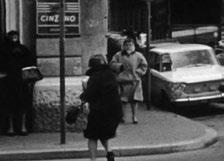
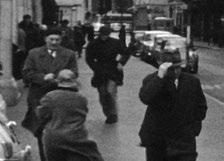
side running along the front wall of Palazzo della Regione (formerly Lloyd Triestino). Just make sure you are standing within the inner half of the square, keeping your distance from the sea… this is the last landmark on the Bora’s way to the Gulf, before she dives into the waters of San Giusto basin: many a heavy vehicle has been swamped and capsized by the wind in this very spot, including a streetcar, a large Turkish truck, several vans, and countless sidecars, motorcycles, and scooters.
If you prefer to start with a test run, then you may want to head towards Piazza della Repubblica, on the corner between Via San Nicolò and Via Dante. There you can have a taste of traditional Bora struggle within a controlled environment, an open-air Bora training ground, as it were, under the gaze of Umberto Saba’s statue. After all, Trieste has always cherished her literature heritage.
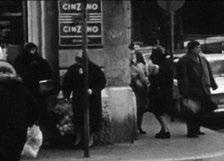
After walking upwind against the Bora, you feel like you can do anything. She is galvanizing. She can give you the strength to face the stress of a day at work, overcome your personal limits, or make an important decision. At least, that is what I think.
In case of ice, however, things change radically. It is no longer about walking, but ice skating! Although days of Bora and ice are likely to happen at least once a year (ask any local you meet), they are, thankfully, quite rare.
After all, in our increasingly warmer world, it is easier to find ice in your glass of spritz!
ENGLISH TEXT
–
Dopo avere camminato controvento nella bora, senti di poter fare tutto.
20 TRIESTE LIFESTYLE IES N°7 — September 2019 Città da scoprire
After walking upwind against the Bora, you feel like you can do anything.
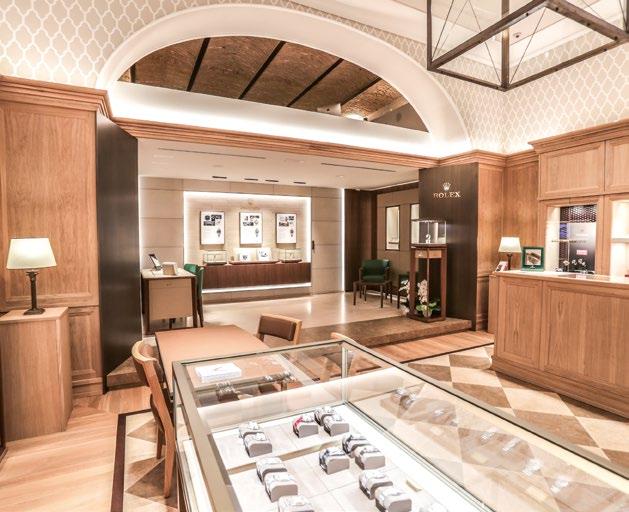
SHOP SPAZIO CAVANA
Il fascino discreto di un itinerario quasi segreto, fra culture, tradizioni, atmosfere, suggestioni, colori e profumi che attraversano la storia e la città vecchia.
Entra in Cavana dal lato di piazza Unità, proprio dove c’è Spazio Cavana. Arriva nella piazzetta e gira fra negozietti, ristorantini, piccole boutique e localini dai drink originali e colorati. Scopri via Diaz, le sue botteghe di sapiente artigianato e gli antiquari dal sapore mitteleuropeo. Non te ne accorgi nemmeno, passi per via della Pescheria, via del Pesce, via del Sale e sei già in via di Cavana, con l’eterno verduraio del borgo e i profumi di “cotto” triestino della salumeria all’angolo. Pochi metri e, dopo le atmosfere di
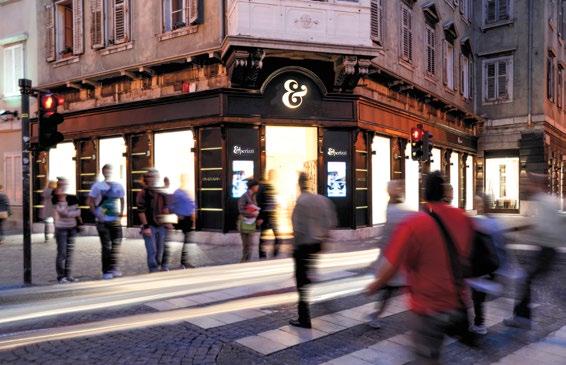
piazzetta Barbacan, sei arrivato: l’Arco di Riccardo, le sue viuzze, i suoi vicoli, i suoi slarghi sono lì, davanti ai tuoi occhi. Scoprili di sera, con il tremolio delle luci delle candele sui tavoli dei locali e l’incredibile incrocio di lingue, culture e tradizioni.
Quando ci si va, partendo da “Spazio Cavana”, proprio all’ingresso di Cavana, si rivive il cammino della Zinelli & Perizzi: dai giorni nostri alle atmosfere che solo il fascino della bellezza classica dell’Arco di Riccardo sa creare.
È una sorta di “cammino nei tempi”, che l’azienda di arredamento, design e oggettistica fondata da Zinelli e Perizzi, ha sempre interpretato tenendo il passo del mercato, ma soprattutto rimanendo fedele alla bellezza
22 TRIESTE LIFESTYLE IES N°7 — September 2019 Città da vivere
dell’arredamento, all’amore per il design, alla qualità della vita all’interno della casa.

Che fossero i tessuti d’arredo della prima fattura (quella storica, del 1925), o la scoperta del design scandinavo degli Anni Sessanta o le lacche trasparenti con le quali per la prima volta (ben 50 anni fa!) sono riusciti a usare le carte da parati per arredare i bagni (ancora intatte!), la Zinelli & Perizzi ha attraversato tempi e mode con una sola stella polare: trasferire, nell’arredamento, la cultura.
E quando la crisi economica ha reso tutto più difficile, alla creatività, all’innovazione e alla sperimentazione ha aggiunto la differenziazione della proposta. Aumentando i punti vendita (Spazio Cavana, Spazio Caboto e Spazio Piccolo) ma conservando l’obiettivo di sempre: preservare la cultura del bello.
Proprio come fa oggi il quartiere antico di Trieste, perchè a Cavana, come in Spazio Cavana, scopri che, nel bello, camminare significa emozionare. [CDL]
The discreet charm of an almost secret itinerary among cultures, traditions, sensations, colours, and scents that can travel through time and space, telling the story of Trieste’s old town.
Turning the corner where Piazza dell’Unità d’Italia meets Cavana neighbourhood, you are welcomed by Spazio Cavana showroom. Let yourself wander through Cavana’s little alleyways, take a look at the tiny shops and boutiques, have a seat at one of the local restaurants or bars, where you can choose from a long list of colourful and original drinks. Proceed then into Via Diaz, with its small handcraft and antique dealers’ shops, where you can breathe an authentic Mittel-European atmosphere. In no time, and almost without you noticing, your stroll will take you through Via della Pescheria, Via del Pesce, Via del Sale, all the way back to Via Cavana, eternally overseen by the ageless local fruit-&-vegetables vendor, and enveloped in the scent of cotto triestino [Trieste’s traditional baked ham, N/T] emanating from the corner deli shop. A few more steps past Piazzetta Barbacan and its peculiar atmosphere, and you have reached your destination: the Arco di Riccardo district, with its narrow streets and steep alleyways, and its unexpected openings widening before your eyes. The best time to visit this part of Trieste is by night, in the flickering candlelight of restaurant tables, surrounded by an incredible mixture of
languages, cultures, and traditions.
Starting this itinerary from the Spazio Cavana showroom means retracing the steps of Zinelli & Perizzi, from the present days all the way back to that magical past, whose beauty only the Arco di Riccardo is able evoke.
It is “a walk through the centuries”, interpreted by interior design and decoration company Zinelli & Perizzi, whose display is a combination of tradition and latest market trends –but whose spirit is first and foremost true to the beauty ideal of interior design, thanks to the company’s passion and respect for quality-of-life highest standards.
The company has navigated seamlessly through manufactured decor fabrics (their most historic creation dating back to 1925), Sixties’ Scandinavian design solutions, and even more astonishing innovations – such as the introduction of transparent varnish for bathroom wallpapers, which are still intact today, half a century after their application. Zinelli & Perizzi’s compass has guided them safely through time and passing trends because it was firmly set on the company’s North Star: interior design as vehicle for culture.
Even in times of crisis, creativity, innovation, and experimentation were never abandoned – rather, they were enhanced through product differentiation. Indeed, while increasing the number of its selling points (now Spazio Cavana, Spazio Caboto, and Spazio Piccolo), the company persevered in its goal: maintaining beauty as a priority.
And it still does today, in the heart of Trieste’s old town, where taking a stroll, like visiting Spazio Cavana, is a profoundly emotional experience.
ENGLISH TEXT
–
Un itinerario quasi segreto fra atmosfere e suggestioni in un incredibile incrocio di lingue, culture e tradizioni che attraversano la storia e la Città Vecchia.
. 23 TRIESTE LIFESTYLE IES N°7 — September 2019 Live the city
The discreet charm of an almost secret itinerary among cultures, traditions, sensations, colours, and scents that can travel through time and space, telling the story of Trieste’s old town.
WALKING IN LITERATURE
Trieste è tante cose, forse troppe. E anche la sua immagine, il modo e i motivi per cui è conosciuta altrove è un’immagine sfaccettata: la città della bora, della Barcolana, della scienza, del caffè. Ma è anche sicuramente, la città della letteratura.
Quale altra cittadina di queste dimensioni può vantarsi di esser stata uno dei più importanti centri di elaborazione e sviluppo della letteratura modernista europea dando vita, in soli tre anni di cui a breve ricorrerà il centenario, al Canzoniere di Saba (1921), all’Ulisse di Joyce (1922) e alla Coscienza di Zeno di Svevo (1923)? Per non dire che in quello stesso 1923 Rilke pubblica quelle Elegie che, per essere duinesi, non possono che far parte di questa storia anch’esse.
Questa è la città in cui gli autori “minori” sono giganti come Scipio Slataper, Vladimir Bartol, Srečko Kosovel, Fulvio Tomizza e via elencando. È la città in cui hanno lavorato e di cui hanno scritto i consoli Richard Francis Burton, Charles Lever, Henri Beyle (Stendhal) e Paul
Morand. La città in cui sono stati scritti capolavori in molte lingue e un potente dialetto. La città in cui la tradizione letteraria è sempre viva con autori noti e tradotti in tutto il mondo fra cui Boris Pahor e Claudio Magris.

Se facciamo un giro per il centro ci accorgiamo immediatamente che ogni muro, ogni via, ogni piazza e gli stessi palazzi che sembrano di solida pietra e marmo, in realtà, sono di carta. Carta scritta.
Cominciamo dalla Stazione dei treni [1], luogo di arrivo per eccellenza. E infatti è qui che il 20 ottobre del 1904 James Joyce arriva a Trieste, riuscendo nella difficile impresa di farsi arrestare pochi minuti dopo (per un equivoco). Poco più avanti, incontriamo quello che proprio Joyce in una lettera al suo amico Italo Svevo definiva “Il canal che viene da lontano per sposare il gran divo, Antonio Taumaturgo [ossia la chiesa neoclassica che si vede lì in fondo, ndr] e poi cambiato parere se ne torna com’è venuto”. Non è un caso se proprio qui una statua di Joyce [2], con svagato incedere, eternamente passeggia.
Proseguiamo lungo le rive, svoltiamo
a sinistra fra la chiesa greco-ortodossa di San Nicolò e il Caffé Tommaseo [3], celebre anche per una poesia di Umberto Saba. Più su in questa stessa via, al numero 30 –casualmente lo stesso indirizzo della “Berlitz School” la scuola di lingue per cui lavorava Joyce– c’è ancora la sua libreria antiquaria [4], con la stessa immutabile atmosfera e, poco lontano, la statua che lo ricorda.
Pochi metri e siamo nel ghetto [5], quello che Saba dipinge a vividissimi colori nei suoi Ricordi-Racconti e che anche Svevo frequentava da bambino per andare alla sinagoga.
Infine sbuchiamo in piazza Unità, proseguiamo per il vivace quartiere di Cavana e giungiamo alla quiete alberata di piazza Hortis [6]: qui sorge lo storico palazzo della Biblioteca Civica che praticamente tutti gli scrittori che abbiamo nominato fin qui hanno conosciuto e frequentato.
Qui troviamo la statua di Svevo, che della biblioteca ha scritto con affetto e qui, proprio di fronte a lui, sorgerà il nuovo LETS, il Museo della Letteratura a Trieste che questa storia racconterà ancora e ancora.
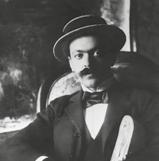 Italo Svevo
Italo Svevo
24 TRIESTE LIFESTYLE IES N°7 — September 2019 Città da scoprire
Rainer Maria Rilke
Trieste is many things, perhaps too many. And for this reason the image it conveys is multi-faceted: it is known as the city of the Bora, of the Barcolana, of science, of coffee. But definitely it is also the city of literature.
There is no other city of this size that can be proud of having been one of the most important centres for the creation and development of European modernist literature. The span of just three years brought to light the Canzoniere by Saba (1921), Joyce’s Ulysses (1922) and Zeno’s Conscience by Svevo (1923). The 100th anniversary of this time will soon be celebrated. Moreover, during the same years, in 1923, Rilke published the Duino Elegies that are indeed part of this story too.


This is the city where “minor” authors are actually “literary giants” such as Scipio Slataper, Vladimir Bartol, Srečko Kosovel, Fulvio Tomizza and so on. This is the city where Consuls such as Richard Francis Burton, Charles Lever, Henri Beyle (Stendhal) and Paul Morand worked and wrote. It is the city where masterpieces have been written in many languages and a powerful dialect. A city where its literary tradition is still alive with famous writers whose works have been translated all over the world, among which are Boris Pahor and Claudio Magris.
If you stroll around the city centre, you realize immediately that every wall, street, square and building that appear to be made of solid stone and marble, are actually made of paper. Written paper.
Let’s start our walk from the Train Station [1], the place of arrival par excellence. Here, on 20 October 1904 James Joyce arrived in Trieste and managed to be arrested a few minutes later (for a misunderstanding). Walking just a bit further, you come across what Joyce in a letter to his friend Italo Svevo
ENGLISH TEXT
5 3
Piazza Hortis
Umberto Saba
James Joyce
Caffè Tommaseo
Stazione dei treni
Statua di James Joyce
Libreria Antiquaria Umberto Saba
1 2 4 6
Ghetto ebraico
Se facciamo un giro per il centro di Trieste ci accorgiamo che ogni muro, ogni via, ogni piazza e gli stessi palazzi che sembrano di solida pietra e marmo, in realtà, sono di carta.
–
Carta scritta.
25 TRIESTE LIFESTYLE IES N°7 — September 2019 Discover the city
Strolling around Trieste city centre, you realize that every wall, street, square and building that seem to be solid stone and marble are actually made of paper.
Written paper.
called “The canal coming from far away to marry the great celebrity, Antonio Taumaturgo [i.e. the neoclassical church you can see down there, N/T] and then, changing his mind goes back as it came”. It is not by chance that Joyce’s statue [2] has been placed here, leisurely walking into eternity.
If you continue along the waterfront, turn left between St. Nicholas GreekOrthodox church and Café Tommaseo [3] , also famous for a poem written by Umberto Saba. Along this street, at number 30 – accidentally the same address of the “Berlitz School”, the language school where Joyce worked – there is his antiquarian bookshop [4] that plunges visitors into the same timeless atmosphere. The statue resembling him stands nearby.
A few more metres and you reach the ghetto [5], the one that Saba describes with bright colours in his “Ricordi–Racconti” [Memories-Stories N/T]. Also Svevo when he was a child used to walk through this neighbourhood to go to the synagogue.
The walk continues to piazza Unità and through the lively district of Cavana and as far as the quiet tree-lined piazza Hortis [6]: here the historical building of the Municipal Library stands, a place where almost all the writers mentioned herein have been.
Svevo’s statue stands right in front of the library that he loved so much. The building will house LETS, the new Literature Museum of Trieste that will tell this story over and over again.
Trieste Città della Letteratura

La grande tradizione letteraria che una passeggiata per il centro della città ci racconta è all’origine della scelta dell’amministrazione comunale di candidare Trieste a città creativa dell’UNESCO per la letteratura. Se l’operazione avrà successo, in novembre Trieste entrerà a far parte di un network di 180 città di tutto il mondo che hanno scelto di fare della creatività un motore di sviluppo sostenibile. Ma di fatto Trieste è già una città della letteratura e i progetti intesi a sviluppare le sue potenzialità –nel campo del turismo culturale ma non solo– non sono occasionali. Sono già in corso i lavori per la realizzazione del nuovo LETS, il museo della letteratura a Trieste che darà vita anche a una casa editrice, LETS Print; allo stesso tempo si lavora ai nuovi itinerari culturali Trieste Metro che alla letteratura dedicheranno un percorso specifico; verrà data attenzione all’innovazione con i progetto di digital humanities e si potenzieranno i programmi di promozione della lettura e di lotta alla povertà educativa (LETS Grow); infine, sotto la sigla LETS Wonder, si prevede di realizzare un importante archivio-museo e una mostra internazionale annuale della letteratura per bambini.

Trieste City of Literature
The great literary tradition you can enjoy by simply strolling around the city centre is the reason that has led the municipal administration to submit Trieste’s application to become a UNESCO Creative City of Literature. In the event of a successful membership, Trieste will join a network of 180 cities all over the world that have chosen to place creativity at the core of sustainable development strategies. In fact, the works for the creation of the new LETS have already started. Trieste’s literature museum will also start a new publishing house, LETS Print; new cultural itineraries with Trieste Metro; programmes to promote reading and overcome educational poverty (LETS Grow); finally LETS Wonder will create and archivemuseum and an international yearly exhibition of children’s literature.
Boris Pahor
26 TRIESTE LIFESTYLE IES N°7 — September 2019 Città
scoprire
Claudio Magris
da
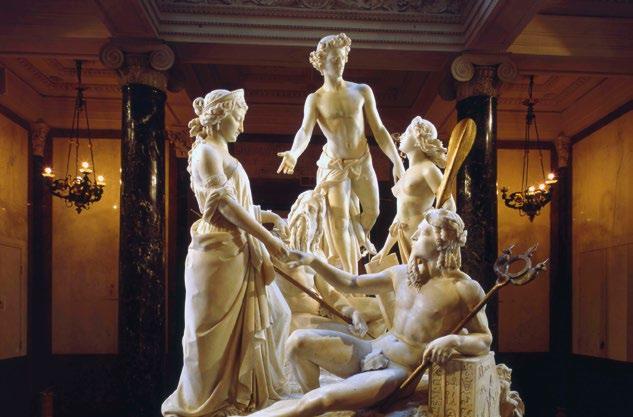


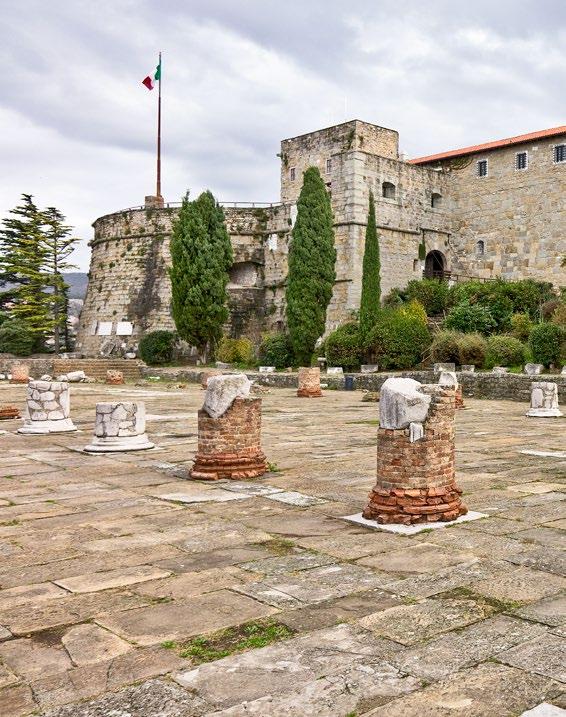 Foto di /Photo by Marino Ierman
Foto di /Photo by Marino Ierman
28 TRIESTE LIFESTYLE IES N°7 — September 2019 Portfolio
–Comune di Trieste, Fototeca dei Civici Musei di Storia ed Arte
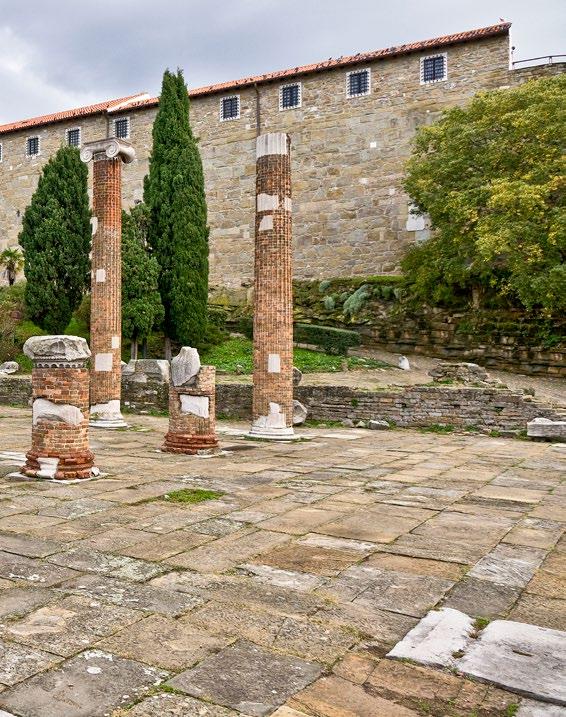
29 TRIESTE LIFESTYLE IES N°7 — September 2019 Portfolio
Il Castello di San Giusto si erge sul colle che domina Trieste, il suo golfo e il suo entroterra. Fu costruito tra 1468 e 1636 per volere degli imperatori d’Austria, come fortezza a difesa della città e alloggio del Capitano imperiale. L’edificazione ebbe inizio con la Casa del Capitano, un’abitazione fortificata affiancata da una torre a “L”, poi inglobata in una fortezza triangolare munita ai tre vertici di bastioni: il Bastione Rotondo o Veneto (1508-1509); il Bastione Lalio o Hoyos (15531557); il Bastione Fiorito o Pomis (completato nel 1636). Il Castello fu residenza dei Capitani imperiali austriaci fino al 1750, quando vi vennero insediate una guarnigione militare e una prigione.
From the city’s highest hill, San Giusto castle overlooks Trieste, her gulf, and her hinterland. The Austro-Hungarian Emperors had it built between 1468 and 1636 a fort to protect the city’s borders as well as the accommodation of the Empire’s Captain general. Construction started with the Casa del Capitano, namely the Captain’s abode, a fortified building flanked by an L-shaped tower, which was subsequently incorporated in a triangle-shaped fortress with a bastion on each peak: Rotund, or Venetian, bastion built between 1508-1509; Lalio or Hoyos bastion, built between 1553-1557, and Flourishing, or Pomis bastion, finished in 1636. The Castle served as residence of the Empire’s Captain generals until 1750, when it was repurposed as a garrison station and a prison.
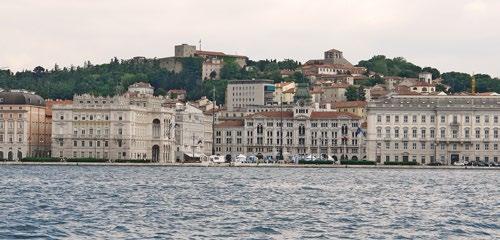
Info www.triestecultura.it www.castellodisangiustotrieste.it 30 TRIESTE LIFESTYLE IES N°7 — September 2019 Portfolio
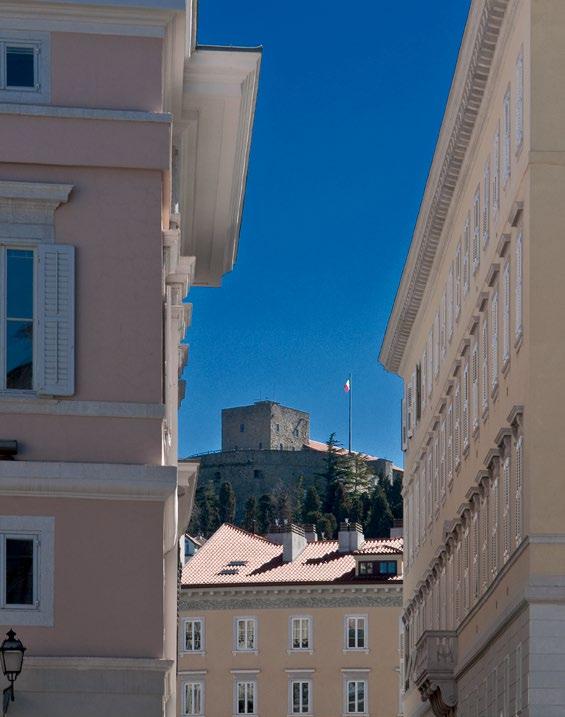
31 TRIESTE LIFESTYLE IES N°7 — September 2019 Portfolio
Cortile delle Milizie
Nel 1936, dopo un radicale intervento di restauro, il Castello fu aperto al pubblico come luogo di cultura e di svago. Oggi ospita due importanti sezioni dei Civici Musei di Storia ed Arte, il Civico Museo del Castello di San Giusto-Armeria e il Lapidario Tergestino. Dagli anni ’30 del ’900 il vasto Cortile delle Milizie, racchiuso dalle mura della fortezza, è sede di spettacoli estivi all’aperto. –
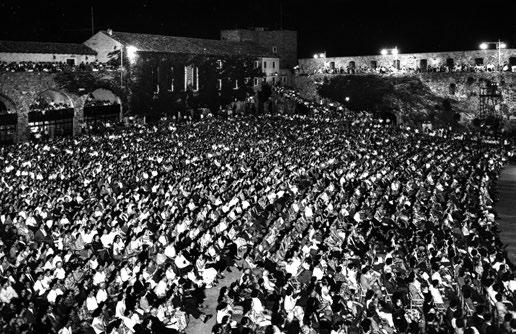
In 1936, after a thorough restoration, the Castle was opened to the public as a space to be used for cultural and leisure events. Today it hosts two important sections of the Civici Musei di Storia ed Arte [City’s museums of Art and History, N/T]: Civico Museo del Castello di San Giusto-Armeria [City’s Museum of San Giusto Castle – Armoury, N/T], and Lapidario Tergestino [Trieste’s Lapidary, N/T]. The ample Cortile delle Milizie [Court of the Knights, N/T] within the fort’s walls hosts open-air events and shows throughout summer.
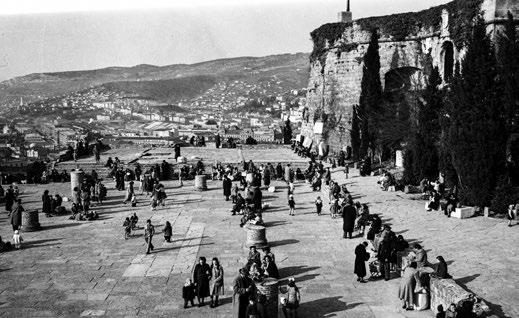 Adriano de Rota – Spettacolo di operetta nel Cortile delle Milizie, 1957
Adriano de Rota – Spettacolo di operetta nel Cortile delle Milizie, 1957
32 TRIESTE LIFESTYLE IES N°7 — September 2019 Portfolio
Giornalfoto – Passeggiata sotto il Castello, 1952


33 TRIESTE LIFESTYLE IES N°7 — September 2019 Portfolio

34 TRIESTE LIFESTYLE IES N°7 — September 2019 Portfolio
Armeria
Recentemente rinnovato nel percorso espositivo, comprende: ambienti tardoquattrocenteschi; una sala introduttiva sulla storia del sito e della città; una ricca Armeria che traccia l’evoluzione dell’armamento in Europa dal Medioevo all’800; la Sala e Antisala Caprin con i pregevoli arredi appartenuti all’editore e patriota triestino Giuseppe Caprin.
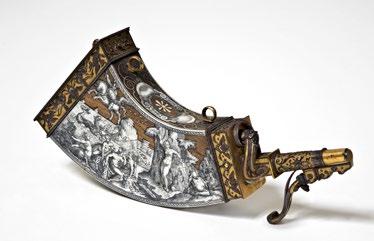
–
This recently restructured venue includes the following areas: the late 15th century wing; an introductory hall offering information on the history of the venue and the city; a rich Armoury displaying the evolution of European weaponry from the Middle Ages to the 19th century; the Grand Hall and the smaller Caprin Hall, showcasing the interior decors that belonged to local publisher and patriot Giuseppe Caprin.

35 TRIESTE LIFESTYLE IES N°7 — September 2019 Portfolio
Lapidario Tergestino
Nei suggestivi sotterranei del Bastione Lalio è possibile ripercorrere la storia della Tergeste romana attraverso i preziosi reperti provenienti dall’area capitolina, dai luoghi di culto, dalle mura, dal Teatro e dalle necropoli, oltre che dagli scavi di una lussuosa villa marittima presso Barcola (fine I secolo a.C. –metà I secolo d.C.).
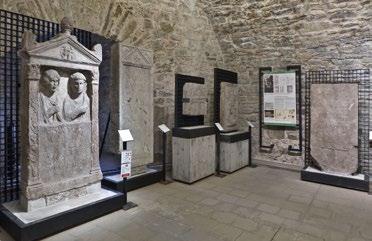
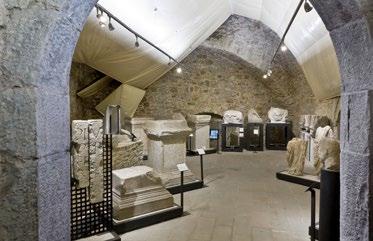
–
Evocative subterranean galleries beneath the Lalio bastion lead visitors back in time, to Ancient Roman Tergeste, through a series of precious artefacts dating back to ancient Rome that were found in local places of worship, the city walls, the Theatre and Necropolis’ ruins, and, more recently, during the excavations of a luxurious seaside villa near Barcola (dating 1st century BC and first half of 1st century AD).
36 TRIESTE LIFESTYLE IES N°7 — September 2019 Portfolio
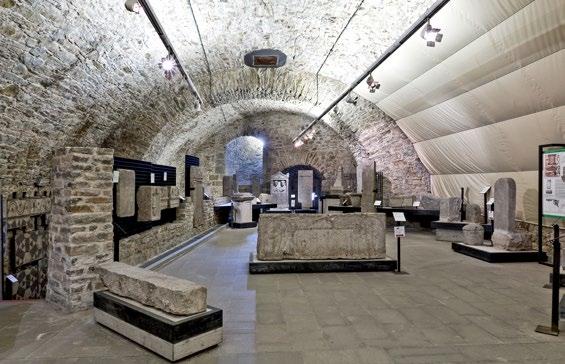
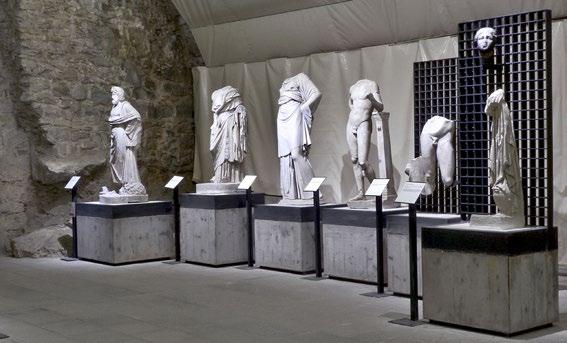
37 TRIESTE LIFESTYLE IES N°7 — September 2019 Portfolio
PAOLO CONDÒ VEDI TRIESTE, E POI MUORI!
di /by Giovanni Marzini
Non ho dubbi: credo che il… vedi Napoli e poi muori… possa venir usato anche per la mia città. Hanno in comune tante cose: uno splendido golfo, con il mare circondato dalle colline. Una bellezza da togliere il fiato. E, credimi, non sono io, non è un triestino a dirlo. In giro per il mondo, ogni volta che ricordo dove sono nato, tutti a dirmi semplicemente… “Trieste, a beautiful place!” Aggiungo una cosa, che accomuna Trieste a Napoli: la filosofia di vita. Credo che il “viva là e po’ bon…” triestino trovi una perfetta traduzione anche nel dialetto napoletano”.
Il segreto di questo successo?
“Trieste è sempre stata bella, da sempre ha un suo fascino particolare. Certo negli ultimi quindici anni è letteralmente esplosa, più che trasformata, si è fatta ancor più bella. Ed è stata scoperta o forse solo riscoperta. Credo che il cambio di passo sia riconducibile al crollo del muro di Berlino, a una Europa più aperta. I turisti (non solo italiani) hanno scoperto l’Istria, la Dalmazia, molte regioni dell’ex Jugoslavia. Magari Trieste era solo una breve tappa nei loro viaggi. Ma basta fermarsi per poche ore, una notte soltanto in questa città e inevitabilmente ti vien voglia di ritornare.”
Parliamo del Condò giornalista, opinionista, ritrattista, volto televisivo: ti sarebbe piaciuto essere più scrittore o romanziere che cronista?

Paolo Condò, giornalista, opinionista e conduttore televisivo, nasce a Trieste nel 1958. Si avvicina al giornalismo iniziando a collaborare con un settimanale locale “Trieste Sport”, prima di approdare al quotidiano della città, Il Piccolo. Dopo qualche anno si trasferisce a Milano, dove viene assunto nel più importante quotidiano sportivo italiano, la Gazzetta dello Sport, che lascia nel 2015, dopo esserne stato una delle prime firme e aver commentato per la rosea, mondiali di calcio, olimpiadi e molti giri d’Italia. Approda quindi in TV, come opinionista a Sky Sport, la TV satellitare con la quale ha da poco rinnovato la sua collaborazione con un contratto pluriennale. Per anni unico giornalista italiano nella giuria che indica il Pallone d’Oro, ha scritto anche numerosi libri di successo, l’ultimo dei quali Un capitano, biografia di Francesco Totti scritta a quattro mani con il campione della Roma, è stato a lungo ai vertici delle classifiche di vendita. Solo poche settimane fa allo stadio Rocco di Trieste ha commentato (per la prima volta in vita sua) una partita della sua squadra del cuore, la Triestina, protagonista di un grande match contro la pluriscudettata Juventus.
Paolo Condò, Italian journalist, essayist, and TV host, was born in 1958 in Trieste. He starts working in journalism first contributing to local weekly sports magazine “Trieste Sport”, and then writing for the local newspaper “Il Piccolo”. A few years later ge moves to Milan, where he is hired by Italy’s main sports newspaper La Gazzetta dello Sport. He spends the following years signing articles on world championships, olympic games, and Giro d’Italia. In 2015 Condò left the press to land on television, where he started working as opinionist for satellite tv channel Sky Sport, with which he just signed a new contract. For years he was the only Italian journalist in the Ballon d’Or jury, and he is the published author of numerous successfull books, including his latest work: Francesco Totti’s biography “Un capitano” [The captain, N/T], written together with Roma’s champion a book that has dominated Italy’s top selling charts for weeks.
A few weeks ago he was at Trieste’s Rocco stadium, commenting a match involving his favourite team, Triestina, that was playing against record holder Juventus FC.
38 TRIESTE LIFESTYLE IES N°7 — September 2019 Città da vivere
“No, per carità, sono molto contento di essere cresciuto sul marciapiede (come giornalista intendo…); scrittori si nasce, difficilmente si diventa. Puoi migliorarti, puoi affinare il tuo scrivere, puoi cercare altri modi di raccontare anche lo sport, ma resti sempre un cronista. Mi piace citare Ryszard Kapuscinski, giornalista, scrittore e saggista polacco che ha definito il giornalista un letterato a piedi!”
Allora ti chiedo il personaggio sportivo che più hai amato raccontare.
“Innegabilmente Francesco Totti. E non solo perché ho scritto con lui la sua biografia. Un grande personaggio, un grande giocatore ma soprattutto un uomo vero! Al pari di Roberto Mancini, attuale c.t. della nazionale. Siamo cresciuti assieme: come calciatore lui, come cronista il sottoscritto. Ritrovarci adesso, con i capelli bianchi, in questi ruoli… è stato proprio bello”.

Facciamo un gioco. Ti chiedo di allestire tre podi, con un primo, secondo e terzo posto nel mondo del calcio, dello sport in generale e al di fuori dello sport. Tre top-three…
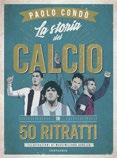
“Per il calcio: Diego Maradona, Arrigo Sacchi e Leo Messi. Nello sport: Mohammed Alì, John McEnroe ed Eddy Merckx. Extra sport: Nelson Mandela, Barack Obama ed Ernest Hemingway”.
Hai vissuto dalle colonne della Gazzetta dello Sport e poi negli studi di Sky l’evoluzione del calcio negli ultimi trent’anni di storia. Come lo immagini tra dieci o vent’anni?
“È il global game per eccellenza. Punto e basta. Sarà sempre più televisivo, ma la gente continuerà a riempire gli stadi. Perché le tv vogliono stadi pieni, con un bel pubblico. La Premier League inglese insegna. E le due cose non sono in contraddizione: la gente continuerà a riempire gli stadi e continuerà a guardare il calcio in tv. Sempre meglio, aggiungo io. E visto che mi stai intervistando per un magazine turistico, aggiungo che il calcio sarà sempre di più anche un veicolo per il turismo. Non c’è pacchetto venduto per una vacanza a Barcellona che non preveda infatti un biglietto per il Barca o la semplice visita al Camp Nou!”
Una volta si diceva che il campionato italiano è il più bello al mondo. Adesso?
“Adesso non siamo più i primi: davanti ci metto il campionato inglese e quello spagnolo, ma subito dietro c’è la nostra serie A. La preferisco alla Bundesliga”.
Un sogno professionale nel cassetto?
“Realizzare uno speciale TV con un viaggio che racconti la storia della ex Yugoslavia. E lo vorrei fare assieme ad una grande uomo e un grande sportivo come Bogdan Tanjevic. E visto che vive a Trieste e tu lo conosci bene… aiutami a realizzare questo progetto”.
Ultima domanda: Trieste–Milano, biglietto di sola andata?
“Dal punto di vista professionale certamente sì. Ma se mi trovi una bella villa in affitto sul mare, giuro che a Trieste ritornerò ogni estate per le vacanze!”
In giro per il mondo, ogni volta che ricordo dove sono nato, tutti a dirmi semplicemente… “Trieste, a beautiful place!”
—
Anywhere in the world, whenever I say that I was born here, people simply say… “Trieste, a beautiful place!”
39 TRIESTE LIFESTYLE IES N°7 — September 2019 Live the city
Le copertine dei due ultimi libri di Paolo Condò: la biografia a quattro mani di Totti e i 50 ritratti per un originale storia del calcio.
There is no doubt in my mind: I believe that ‘See Naples and die’ applies perfectly to my home. After all, Naples and Trieste share a lot: a beautiful gulf, a sea surrounded by hillsides… a breath-taking beauty. And, believe me, I am not saying it because I am a Triestino. Actually, I am not the one saying it at all: anywhere in the world, whenever I say that I was born here, people simply say… ‘Trieste, a beautiful place!’. But I am going to add this to the list of things Naples and Trieste share: the way of life. I think Trieste’s old saying ‘viva là e po’ bon’ [lit. cheers there and then whatever] could find a perfect translation in Naples’ vernacular.”
Why is Trieste so popular?
“Trieste has always been beautiful, in her own unique way. True, the city has developed into a fully-fledged tourists’ attraction in the last 15 years, but she did not change if anything, this turn of events made her even more beautiful. She was discovered, or rather re-discovered. A change of heart that could be traced back to the fall of the Berlin wall, a more open Europe. While Italian and foreign tourists were returning to Istria, Dalmatia, and numerous other regions of former Yugoslavia, Trieste may have been just a short stop on their way there a few hours, maybe one night. But that was all it took to make them want to come back.”
Let us talk about Condò the
journalist, opinionist, portraitist, and TV personality: would you have liked to be a writer or novelist rather than a reporter?
“No, for Heaven’s sake, I am glad I grew up on the street as a journalist, I mean… one could never become a writer, they are born that way. As a reporter, well… you can try to grow, improve your writing, find new ways of telling about sports, for instance, but you are still a reporter. I am fond of the words uttered by Polish journalist, writer, and essayist Ryszard Kapuscinski, who defined a journalist as a scholar left with no option but to walk.”
The my question is: is there an athlete, whose tale you loved to tell?
“Francesco Totti, without a doubt. And not just because I co-authored his biography. He is first and foremost a great personality, a formidable player… and, most importantly, a true man…! Much like Roberto Mancini, current manager of Italy’s national team. We grew up together, as football player and reporter, respectively. Seeing each other today, with white in our hair and new jobs… it was really something.”
Let us play a game: imagine that
you have three podia to fill with winners of three categories: a first, second, and third place for football, sports in general, and everything else…
“Football: Diego Maradona, Arrigo Sacchi, and Leo Messi. Sports in general: Mohammed Alì, John McEnroe, and Eddy Merckx. Everything else: Nelson Mandela, Barack Obama, and Ernest Hemingway.”
As journalist, you have lived through thirty years of football history, from the columns of Gazzetta dello Sport to Sky studios. How do you see the next ten to twenty years?
“Football is THE global game par excellence. Full stop. It will be increasingly televised, but people will still fill the stadiums. Also because television needs a full stadium, as witnessed the English Premier League. After all, the two go hand in hand: football fans will always watch football games, either live or on TV. And both experiences will improve. Since I am being interviewed for a tourist magazine, I shall add that football will increasingly become a tourist magnet. No Barcelona holiday package lacks a Barca ticket or a visit to Camp Nou stadium!”
The Italian championship used to be a world’s favourite. What about now?
“We are no longer the top of the tops: in my opinion, we hold the third place, after the English and the Spanish championship. I still believe our serie A is better than the Bundesliga.”
Your secret professional dream?
“A TV special on the history of former Yugoslavia. Possibly with a great person and athlete such as Bogdan Tanjevic. I know he lives in Trieste and you know him so… help me make my dream come true.”
Last question: Trieste-Milan. One-way ticket?
“Professionally, yes. But if you find me a beautiful villa with a sea view to rent, I promise I will be spending every summer holiday in Trieste!”
ENGLISH TEXT
—
Trieste negli ultimi quindici anni è letteralmente esplosa, più che trasformata si è fatta ancor più bella. Ed è stata scoperta o forse solo riscoperta.
40 TRIESTE LIFESTYLE IES N°7 — September 2019 Città da vivere
The city has developed into a fully-fledged tourists’ attraction in the last 15 years, but she did not change if anything, this turn of events made her even more beautiful.
Portopiccolo Spa by Bakel: dimenticati del resto. I tuoi sensi si risveglieranno per entrare nell’universo parallelo del benessere.


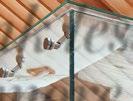


www.portopiccolo.com
Portopiccolo è Real Estate / Rental Apartments / Falisia, a Luxury Collection Resort & Spa / Spa by Bakel / Med in Blue - Medical Spa / Beach Club / Marina & Yacht Club / Restaurants & Shops.
FVG WORLD
di /by Isabella Franco
Un piccolo regalo pieno di tutto ciò che amiamo dell’Italia”: è la definizione, ma anche l’elogio, se non l’atto di amore, di Dana Facaros e Michael Pauls, al Friuli Venezia Giulia.
I due, autori ed esperti viaggiatori, hanno appena dato alle stampe la prima guida turistica in lingua inglese interamente dedicata al Friuli Venezia Giulia. L’editore è uno dei più famosi e blasonati nel settore delle guide turistiche: Bradt, fondata nel 1974 e oggi leader internazionale nel segmento medio-alto con lettori di cultura elevata e buona disponibilità economica.
Dana Facaros e Michael Pauls raccontano tutto il meglio del Friuli Venezia Giulia, che definiscono “una delle regioni italiane meno conosciute ma sempre più popolari”, “un luogo comodo e affascinante per trascorrere del tempo in spiaggia, nelle Alpi o rilassarsi in campagna”, che “si distingue anche per i suoi vini e la sua cucina particolare”, con contaminazioni dall’Austria e dalla Slovenia.
In 280 pagine esplorano la regione in dettaglio, evidenziano il carattere di ogni località, danno suggerimenti al turista per rendere unica la sua esperienza in regione, come percorrere l’Alpe Adria Trail a cavallo del confine, fare canyoning in Carnia, meravigliarsi davanti agli affreschi dei palazzi di Spilimbergo, esplorare la costa e la laguna di Grado e Lignano, emozionarsi sui declivi delle colline del Collio.
Non poteva mancare tra gli highlights e nel capitolo “Don’t Miss – Da non perdere” la caffeine-mad Trieste, “pazza per la caffeina", dove ci sono 67 modi diversi di ordinare una tazza di caffè”. Uno degli aspetti del capoluogo presi in considerazione assieme al suo carattere multiculturale e all’altera bellezza mitteleuropea.
La guida Bradt dedicata al Friuli Venezia Giulia, realizzata con la collaborazione di PromoTurismoFvg, è in vendita in oltre cento Paesi nel mondo ed è disponibile sul sito dell’editore www.bradtguides.com, sia nella versione cartacea, sia come e-book.
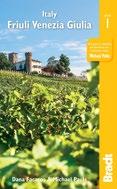
La Bradt si aggiunge alle numerose pubblicazioni dedicate al Friuli Venezia Giulia, che vedono dietro le quinte il lavoro di PromoTurismoFVG, fra le quali le due edizioni italiane della Lonely Planet e la guida sui percorsi cicloturistici regionali di La Repubblica.
ENGLISH TEXT
Alittle present with all the things we love about Italy”: this is the definition of and a tribute, a love declaration even, to Friuli Venezia Giulia (FVG), as written by Dana Facaros and Michael Pauls, published authors and expert travellers.
Their comprehensive guide to Friuli Venezia Giulia published in English, a real pioneer in its genre, has just been released by Bradt Travel Guides publisher. Founded in 1974, Bradt very soon acquired a reputation for tackling destinations overlooked by other guide publishers, eventually becoming a leading independent travel publisher, particularly appreciated by a highly educated, well-to-do readership.
Dana Facaros and Michael Pauls write about the very best of FVG, a region they describe as a “long-neglected corner” of Italy, yet “one of [its] last choice” regions, a convenient yet fascinating spot where you can easily choose between seaside relaxation, a walk in the Alps, or a stroll in the countryside, with a remarkable selection of wines and a unique traditional cuisine, full of Austrian and Slovene influences.
In 280 pages the authors explore every corner of this region, identifying the distinct character of each area and suggesting lesser known trails to make one’s visit unique, such as the Alpe Adria Trail running across the border, Carnia canyoning routes, the remarkable frescos’ itineraries throughout the Spilimbergo palaces, Grado and Lignano breathtaking walks alongside the coast and lagoon, and an unforgettable visit to the cliff sides of Collio hills.
The chapter “Don’t Miss” could not avoid caffeine-mad Trieste, “where there are 67 different ways to order a cup of coffee” one of the many distinct aspects of the city, alongside her multi-cultural atmosphere and proud, Middle-European beauty.
Bradt’s FVG Travel Guide, written in cooperation with PromoTurismoFvg, is now available in more than one hundred countries, and may also be purchased online at www.bradtguides.com, either as paperback or e-book.
It is the latest of a long list of international publications on FVG supported by PromoTurismoFVG, alongside the two editions of Lonely Planet’s Italian FVG travel guides and La Repubblica’s guide on regional bicycle tourism.
“ 42 TRIESTE LIFESTYLE IES N°7 — September 2019 Città da vivere
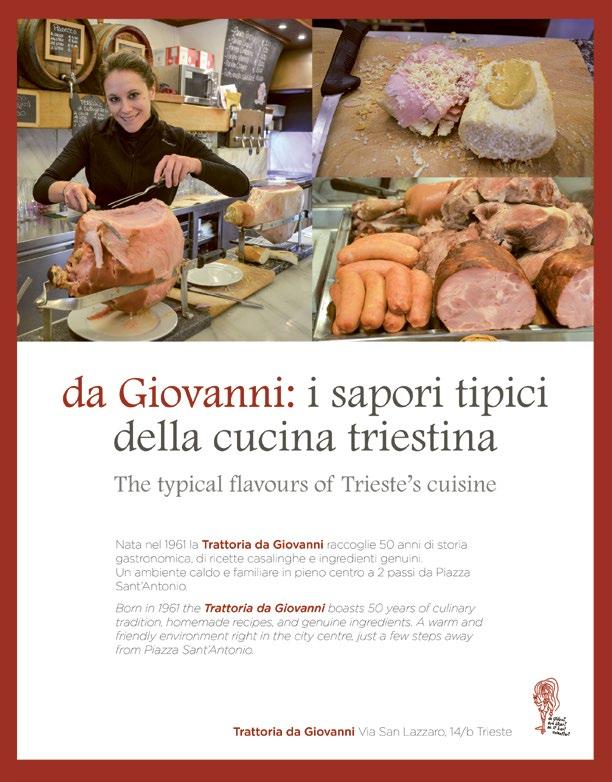
La scienza a portata di mano

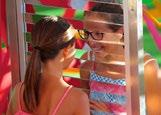
HANDS ON SCIENCE
Un museo della scienza, interattivo e sperimentale, adatto a tutti, dove la scienza diventa divertimento e sperimentare è la parola d’ordine, soprattutto dove il “non toccare” è severamente vietato: è l’Immaginario Scientifico, a due passi dal Castello di Miramare, méta ideale per una sosta dopo la visita al Castello o una passeggiata nel meraviglioso Parco.
In questa tappa dei Percorsi nella Trieste della Scienza, tutto è all’insegna della scoperta e della conoscenza. Nelle sale i visi dei bambini si illuminano, gli occhi brillano curiosi ed emozionati mentre vivono esperienze
 di /by
di Ilaria Romanzin
di /by
di Ilaria Romanzin
44 TRIESTE LIFESTYLE IES N°7 — September 2019 Città da vivere
Where science is fun and experimenting is the only rule, especially because “do not touch” here does not apply. An unprecedented experience of discovery and knowledge.
incredibili: si creano tornadi, si scatenano vortici d’acqua, si bisbiglia in un buchino e ci si sente all’altra parte di una stanza, si accende un fiammifero con una lampadina, si entra in una bolla di sapone… oppure… si fotografa la propria ombra, facendo invidia persino a Peter Pan!
Novità di quest’anno l’allestimento dal titolo L’alfabeto delle scienze esatte, dedicato alla matematica.

Con musiche suggestive e immagini proiettate su maxischermi, genetica, geografia, evoluzione, grandi scoperte, astronomia e geologia sembrano vicine ed emozionanti.
Nel planetario si potrà vivere in poco tempo l’esperienza di un’intera notte: nel buio avvolgente, costellato

da migliaia di puntini luminosi, si dispiegano le caratteristiche del Sistema Solare e della Luna.
Nelle sezioni Demo.lab e X.lab la scienza si vive partecipando, da soli o in famiglia, a esperimenti e dimostrazioni o svolgendo attività di tinkering ideando e costruendo oggetti o marchingegni, con materiali nuovi o di recupero, lasciandosi guidare dalla propria inventiva e dalla manualità.
Emozione pura per i più giovani (7-11 anni) è la notte al museo!!! I bambini, guidati da un famoso personaggio della storia della scienza, saranno coinvolti in diverse attività per poi “dormire” tutti assieme in una delle sale del museo e far ritorno a casa il mattino seguente!


Dove la scienza diventa divertimento e sperimentare è la parola d’ordine, il “non toccare” è severamente vietato. Tutto è all’insegna della scoperta e della conoscenza.
–
45 TRIESTE LIFESTYLE IES N°7 — September 2019 Live the city
Ascience museum, an interactive experience for visitors of all ages, where science is fun and experimenting is the only rule, especially because “do not touch” here does not apply: Immaginario Scientifico [Science centre Immaginario Scientifico , N/T] is just a short walk away from Castello di Miramare and therefore a natural choice of destination after a visit of the castle or a stroll in its wonderful Park.
Immaginario Scientifico is also part of the Itineraries through Trieste of Science, offering an unprecedented experience of discovery and knowledge. The eyes of younger visitors light up with excitement as they let their curiosity guide them through the museum, discovering new wonders at every corner: here they can create a tornado, start a whirlpool, whisper in a tiny hole in the wall and hear their own voice coming from a different room, light a match with a light bulb, enter a soap bubble…and even snap a picture of their own shadow, quicker than Peter Pan!
This year’s new attraction is L’alfabeto delle scienze esatte [The alphabet of exact sciences, N/T], a layout entirely dedicated to mathematics.
Evocative music and images projected on large screens enhance the experience of genetics, geography, evolution, history, astronomy, and geology – making them more exciting and bringing them closer than they’ve ever been before.
The wonders of an entire night can be enjoyed in just a few moments in the planetarium, where the Moon and Solar system unveil their secrets surrounded by a thick, enveloping darkness interrupted here and there with scattered bright dots.
There are two laboratories, Demo. lab and X.lab, where visitors – alone or
with their family – can be active participants in experiments and demonstrations, do some tinkering around, design and create objects and contraptions using scraps or new materials, unleashing their creativity and craftiness.
And, finally, the museum’s most popular attraction and source of pure excitement for young visitors (7 to 11 years old): a night at the museum. A famous historical scientist will guide our little guests through a series of activities until bedtime comes and everyone goes to “sleep”, all together in one of the museum’s rooms, before going home on the following day.
Info
www.immaginarioscientifico.it www.triestecittadellascienza.it/ scopri-la-scienza/
Esof 2020 per i bambini
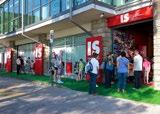
Esof 2020 dedicherà nelle giornate del forum uno spazio anche ai bambini e alle famiglie.
Sono previsti laboratori didattici dedicati ai più giovani –realizzati in collaborazione con musei internazionali–mostre, veri e propri science show: spettacoli a tema con la partecipazione di nomi di spicco del settore, tra i quali lo scenografo francese Didier Gallot Lavallée.
Una particolare mostra di immagini in ambito medico e biomedico sarà realizzata con L'Istituto Italiano di Tecnologia e Istituto Italiano di Tecnologia di Genova. Il forum si svolgerà dal 5 al 9 luglio 2020.
During the days of EuroScience Open Forum (Esof) 2020 there will be a space entirely devoted to children and families.
Young guests will be able to choose among a wide range of activities, such as educational workshops in cooperation with international museums exhibits, and reallife science shows, i.e. theme performances with the participation of field experts, including French scenographer Didier Gallot Lavallée.

The Italian Institute of Technology and the Genoa Istituto di Tecnologia will offer a visual exhibit on the topic of medicine and biomedicine. The forum will take place between 5th and 9th July 2020.
Info
www.fondazioneinternazionale. org/trieste-esof-2020-cittaeuropea-della-scienza/
ENGLISH TEXT
46 TRIESTE LIFESTYLE IES N°7 — September 2019 Città da vivere
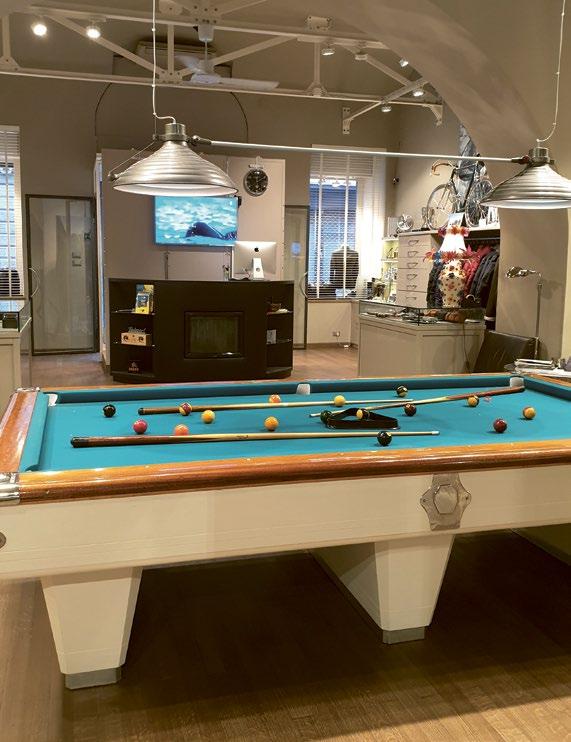
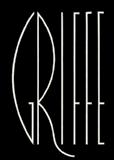
LA CITTÀ DELLA MODA
Oggi Trieste è voglia di sperimentare, di creare e stupire. Il mix è vincente tra il passato, fatto di accessori e abiti in stile vintage, e il desiderio di modernità, tra materiali e forme di tendenza.
–
Today Trieste’s fashion landscape is the expression of a desire to experiment, create, and amaze. It successfully merges past with present, vintage clothing and accessories with state-of-the art shapes and materials.

48 TRIESTE LIFESTYLE IES N°7 — September 2019 Città da vivere
di /by Micol Brusaferro
L’indimenticabile genio Ottavio Missoni, il grande evento ITS International Talent Support e poi spazi creativi, botteghe, negozi artigianali, e bellezze che hanno calcato passerelle internazionali. Trieste ha un legame storico e indissolubile con la moda.

Dal passato si erge un nome su tutti, Ottavio Missoni, lo stilista nato a Ragusa, nell’allora Jugoslavia, ma che proprio a Trieste, dove si era trasferito da ragazzo, ha iniziato la sua lunga e strepitosa carriera, dopo aver aperto un laboratorio di maglieria insieme all’amico e come lui grande sportivo Giorgio Oberweger. Sarà insieme alla moglie che consoliderà un successo inarrestabile, sperimentando con i colori e conquistando i mercati internazionali. Ma con Trieste sempre nel cuore. Lo dice, commosso, nel 2008, mentre riceve la cittadinanza onoraria dal Comune, rispolverando un dialetto che non ha mai dimenticato: “Questa xe come fossi stada sempre casa mia”
Non sono stati solo i colori di Missoni a portare Trieste sulle passerelle di

tutto il mondo. Ci sono anche due Miss Italia, Susanna Huckstep, iconografico sex symbol degli anni Ottanta, protagonista di tanti servizi fotografici e défilé, e ancora prima Alda Balestra. Quest’ultima in particolare, dopo l’incoronazione nel 1970, ha vissuto a Milano, Parigi e New York, è stata scelta da Gianni Versace per le sue sfilate, immortalata sulle pagine Vogue e altre riviste del jet set. Con lei, Trieste è stata protagonista negli States della campagna pubblicitaria dell’Oreal e dei brand più conosciuti dal 1975 al 1992.
Oggi Trieste è voglia di sperimentare, di creare e stupire. Sono tanti i negozi sorti soprattutto nel cuore della città, tra Cavana e le stradine del centro, dove tra scaffali e vetrine il mix è vincente tra il passato, fatto di accessori e abiti in stile vintage, e il desiderio di modernità, tra materiali e forme di tendenza.
E guardando al futuro Trieste è ITS, manifestazione ormai consolidata, che valorizza sempre più giovani stilisti in arrivo da tutto il pianeta e che sta costruendo una novità unica nel suo genere, Arcademy. Un grande contenitore, dove ITS vi insedierà i propri uffici e i
49 TRIESTE LIFESTYLE IES N°7 — September 2019 Live the city
Susanna Huckstep
suoi famosi archivi, che saranno aperti al pubblico, tantissimi lavori frutto delle candidature ricevute nel corso degli anni, oltre a elementi di collezioni realizzate dai finalisti del concorso. Oltre settemila portfolio, centinaia di vestiti, accessori e gioielli e migliaia di immagini.
“Tutta la nostra energia è focalizzata ora su Arcademy, che aprirà a luglio 2021 in occasione dei vent’anni di ITS –spiega Barbara Franchin, ideatrice e cuore dell’evento– sarà per tutti un punto di riferimento mondiale per la creatività e la moda contemporanea”.
ENGLISH TEXT
LUnforgotten and unforgettable fashion genius Ottavio Missoni, the International Talent Support event, and much more creative workshops, handcraft shops, and beauties that have tread the most important catwalks of the world.


Trieste enjoys a long-lasting, indissoluble connection with fashion.
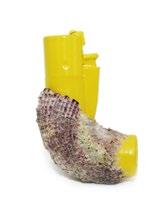
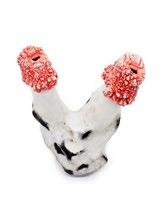
One historical name stands out above all others: Ottavio Missoni, born in Dubrovnik (then Ragusa di Dalmazia), who moved to Trieste in his teens, where he started his long and bright designer career: after the war, Ottavio and his team mate Giorgio Oberweger launched an activewear business in

Trieste making wool tracksuits. Later on, with his wife Rosita Jelmini, Missoni consolidated his sky-rocketing career by experimenting with colours, which led to his success on the international market. But Trieste always remained in his heart as he confirmed in 2008, while receiving honorary citizenship by Trieste’s municipality, and expressing gratitude in the local dialect: “Questa xe come fossi stada sempre casa mia” [It is as if this has always been my home, N/T].
However, Missoni’s colours are not the reason why Trieste has reached the catwalks of the world. It was first and foremost thanks to two Miss Italia winners: Susanna Huckstep, main face of numerous photo shoots and runway shows; and Alda Balestra before her. Balestra won Miss Italia in 1970, when she moved to Milan, and later Paris and
50 TRIESTE LIFESTYLE IES N°7 — September 2019 Città da vivere
New York, eventually becoming one of Versace’s favourites from that moment on her face populated the front pages of Vogue and numerous other jet-set magazines. She brought Trieste along when she travelled to the United States to feature in one of L’Oréal’s most famous campaigns, followed by other renowned brands’ campaigns, from 1975 to 1992.
Today Trieste’s fashion landscape is the expression of a desire to experiment, create, and amaze. In the very heart of the city countless little shops colour the streets between Cavana and the main shopping area, with window shops that successfully merge past with present, vintage clothing and accessories with state-of-the art shapes and materials.
As regards the future, Trieste’s
International Talent Support (ITS) event offers a forward-looking perspective, promoting international young stylists and launching its unique Arcademy: a huge space hosting ITS’ offices and famous archives, which will soon be open to the public and will display a wide array of artworks, including stylists’ submissions received by ITS over the years, as well as collections of finalists’ creations, for a total of 7,000 portfolios, hundreds of clothing items, accessories, jewels, and thousands of pictures.
“We are focusing all our energy on Arcademy, which will be inaugurated in July 2021, marking ITS’ 20th anniversary says project creator and head organiser Barbara Franchin it will be an international reference point for creativity and contemporary fashion”.




“Arcademy, aprirà a luglio 2021 –in occasione dei vent’anni di ITS– e sarà per tutti un punto di riferimento mondiale per la creatività e la moda contemporanea.”
–
51 TRIESTE LIFESTYLE IES N°7 — September 2019 Live the city
“Arcademy, which will be inaugurated in July 2021 –marking ITS’ 20th anniversary– will be an international reference point for creativity and contemporary fashion.”
ROSSETTI THEATER

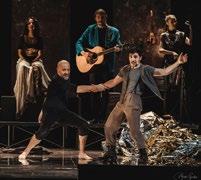



52 TRIESTE LIFESTYLE IES N°7 — September 2019 Città da vivere
di /by Ilaria Lucari
A rich and varied season consisting of the best Italian plays and enthralling national and international musicals, dance and concerts.
Il sipario del Politeama Rossetti si alza su una stagione ricca e molto varia, che intreccia i migliori spettacoli di prosa del panorama italiano ad affascinanti proposte nazionali ed internazionali di musical, danza e concerti. Lo spettacolo inaugurale (dal 22 al 27/10) è un’assoluta novità, creata proprio a Trieste dal Teatro Stabile del Friuli Venezia Giulia: si tratta de “L’onore perduto di Katharina Blum” di Heinrich Böll, con Elena Radonicich e Peppino Mazzotta diretti da Franco Però. Lo spettacolo si sviluppa come un giallo e denuncia la deriva e la violenza del mondo dei media e della comunicazione. Subito dopo (29/10 -17/11) “L’infinito tra parentesi” di Marco Malvaldi per la regia di Piero Maccarinelli porta protagonisti eccellenti: Maddalena e Giovanni Crippa. Completano la notevole proposta di prosa un successo internazionale come “Le ultime lune” di Furio Bordon (dal 6/11), l’esilarante “Rumori fuori scena” di Michael Frayn (dal 20/11) e il nuovo spettacolo di Marco Paolini (dal 27/11). Per chi ama la musica, è perfetto “The Choir of Man” (14-17/11) che ha conquistato l’Edinburgh Fringe Festival. Lo show avvolge il pubblico nell’atmosfera allegra di un (vero) pub dove un cast tutto maschile esegue un crescendo di numeri musicali e coreografici, dal pop al musical. “Aggiungi un posto a tavola” con Gianluca Guidi è un cult con le sue celebri melodie e arriva a Trieste nell’imponente allestimento originale (dal 5/12). L’Harlem Gospel Choir porta al Politeama Rossetti la vera atmosfera natalizia, il 21 e 22 dicembre con musiche travolgenti e voci incantevoli. Il 23 dicembre invece è di scena la danza del repertorio più
romantico e amato: “Lo Schiaccianoci” di Čiaikovskij nell’esecuzione del Russian Classical Ballet, una formazione impeccabile che segue la grande tradizione classica russa. Interessante anche il ventaglio di concerti che accompagnano la stagione: si inizia con la doppia data (25 e 26/11) della sacerdotessa del rock, Patti Smith, una vera leggenda. Biglietti e informazioni www.ilrossetti.it o al tel. +39 040 3593111.
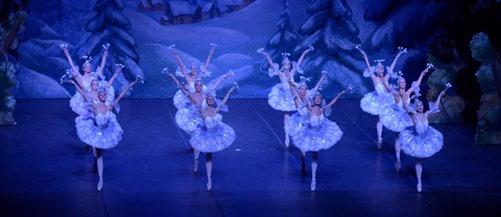
ENGLISH TEXT
The curtain of the Politeama Rossetti will go up for a rich and varied season consisting of the best Italian plays and enthralling national and international musicals, dance and concerts. The opening show (from 22 to 27/10) is the first of its kind, created in Trieste by the Teatro Stabile del Friuli Venezia Giulia: “The Lost Honour of Katharina Blum” by Heinrich Böll, with Elena Radonicich and Peppino Mazzotta directed by Franco Però. The story is a thriller and deals with how violence can develop in the world of media and communication. Then (29/10 -17/11) “L’infinito tra parentesi” [The infinite in brackets, N/T] by Marco Malvaldi directed by Pero Maccarinelli will follow, featuring excellent actors: Maddalena and Giovanni Crippa. In addition to this the international success of “Le ultime lune” [The Last Moons, N/T] by Furio Bordon
Una stagione ricca e varia che intreccia i migliori spettacoli di prosa, musical, danza e concerti.
–
53 TRIESTE LIFESTYLE IES N°7 — September 2019 Live the city
(from 6/11), the exhilarating “Noises off” by Michael Frayn (from 20/11) and the new show by Marco Paolini (from 27/11). If you love music you cannot miss “The Choir of Man” (14-17/11) that conquered the Edinburgh Fringe Festival. The show creates the joyful atmosphere of an authentic pub where an all-male cast performs a crescendo of music acts and choreographies from pop to musicals. “Aggiungi un posto a tavola” [Add a place at the table, N/T] with Gianluca Guidi is a cult show with its famous melodies and will be in Trieste with an imposing original set design (from 5/12). The Harlem Gospel Choir will bring the true Christmas atmosphere to the Politeama Rossetti, on 21 and 22 December with overwhelming music and enchanting voices. On 23 December the most romantic and beloved ballet will be on stage: the Russian Classical Ballet will perform “The Nutcracker” by Tchaikovsky, impeccable dancers following the great classic Russian tradition. The season will also feature an interesting range of concerts: starting with two gigs (25 and 26/11) of the Priestess of rock, Patti Smith, a true legend.
La Contrada
Ma nella città dei teatri non può esserci solo un cartellone di prosa. Ecco allora che accanto allo Stabile del Friuli Venezia Giulia, negli anni si è ritagliato uno spazio sempre più grande e ricco di ottime produzioni anche “la Contrada”, che sulle ceneri dell’ex cinema Cristallo, nell’immediata periferia della città ha creato il Teatro Bobbio, in memoria del suo ideatore e fondatore. All’insegna della tradizione, il programma dello Stabile di Trieste aprirà la stagione con “Nuovo Cine Swarowsky”, una produzione che giocando già nel titolo con la parola… cristallo, vuol ricordare un po' la storia e le origini di questo teatro. La divertente piece, che vedrà tra i protagonisti Ariella Reggio, iconografica attrice del teatro dialettale (ma non solo) per questa città, andrà in scena dal 18 al 31 di ottobre. Tra i quasi 30 spettacoli che caratterizzano il cartellone della Contrada sino a maggio inoltrato, vogliamo ricordare ancora i due titoli per il mese di novembre: “La camera azzurra” di Georges Simenon con Fabio Troiano e Irene Ferri dal’8 al 13 e “8 donne e un mistero” di Roberto Thomas con Anna Galiena, Debora Caprioglio, Caterina Murino e Paola Gassman, dal 22 al 25. [GM]


But in the city of theaters, there must be more than one playbill. So in addition to the offer of the Stabile del Friuli Venezia Giulia, over the years, many excellent plays have been produced by “la Contrada”, at the Bobbio theatre, named after its creator and founder, in the building that once hosted the Cristallo Cinema, just outside the city centre.
Following tradition, the programme of the Stabile di Trieste will open the season with “Nuovo Cine Swarowsky”, a performance with a special title, that plays on the word ‘crystal’ to remind of the origins and history of this theatre. The funny show featuring Ariella Reggio, famous local actress of plays in Triestine dialect (but not only), will be on stage from 18 to 31 October.
Among the almost 30 shows offered by the Contrada playbill on stage until mid May, we would like to point out the two plays in November: “The Blue Room” by Georges Simenon with Fabio Troiano and Irene Ferri from 8 to 13 and “Eight Women” by Robert Thomas with Anna Galiena, Debora Caprioglio, Caterina Murino and Paola Gassman, from 22 to 25. Info
Teatro Orazio Bobbio
Via del Ghirlandaio,12
34138 – Trieste
contrada@contrada.it
www.contrada.it
54 TRIESTE LIFESTYLE IES N°7 — September 2019 Città da vivere
CASUAL prêt-à-porter BoUtIQUe AND ACCeSSorIeS
FILM
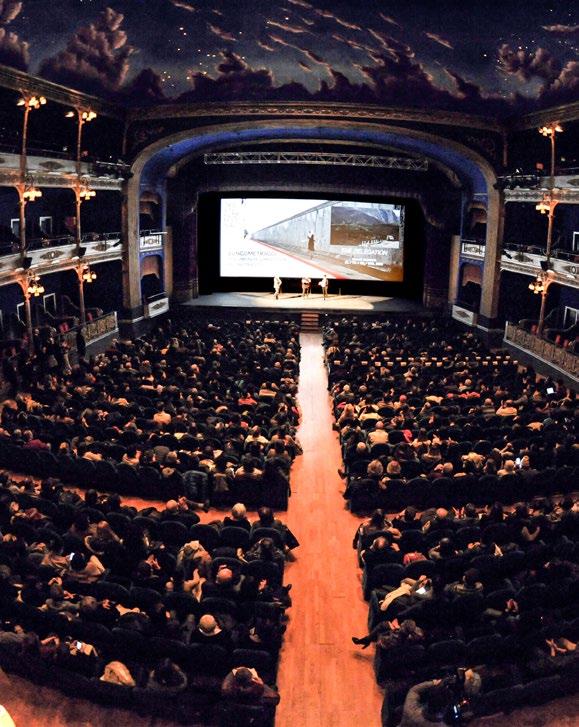
56 TRIESTE LIFESTYLE IES N°7 — September 2019 Città da vivere
FESTIVAL &
Sarà perché a Trieste c’è il più antico corso universitario di Storia del cinema o per la caratteristica multiculturale di questa città di confine e di frontiera sempre aperta e curiosa a tutte le novità, fatto sta che a Trieste si respira la magia della settima arte tutto l’anno grazie all’offerta culturale di ben quattro Festival di cinema.
Chiara Valenti Omero, vicepresidente dell’Associazione Casa del Cinema di Trieste, nonché Presidente dell’Associazione Festival Italiani di Cinema e di Maremetraggio –festival che in estate offre una selezione dei migliori cortometraggi internazionali– mette in risalto “le forti personalità distinte dei Festival che, svolgendosi tutti in periodi differenti, da gennaio a novembre, danno il via a un Festival lungo un anno!”.
Tutte le manifestazioni richiamano appassionati dai cinque continenti e sono sempre seguiti anche dagli stessi triestini, da sempre legati al cinema. Si pensi che la prima sala a Trieste fu aperta già nel 1905, appena dieci anni dopo

la prima proiezione dei fratelli Lumière.
Settembre è tempo de “I Mille occhi Festival Internazionale del cinema e delle arti” che offre la sua guida per i mille possibili sguardi e percorsi alla riscoperta del cinema del passato; in autunno il protagonista assoluto è il Trieste Science+Fiction Festival, nato nel 2000 dalle ceneri del Festival di Fantascienza (1963-1982). Quest’anno la principale manifestazione italiana dedicata alla fantascienza che ha portato a Trieste nomi del calibro di Rutger Hauer, l’indimenticabile replicante di Blade Runner scomparso da poco, si svolgerà dal 29 ottobre al 3 novembre.
Il nuovo anno a Trieste inizia oramai da tre decenni in compagnia del Trieste Film Festival: dal 17 al 22 gennaio 2020 la 31a edizione di questo Festival darà voce a tutte le espressioni cinematografiche dei Paesi dell’Europa Centrale e Orientale. A conferma che Trieste, porta verso l’Est, luogo di incontro tra Oriente e Occidente, è da sempre luogo privilegiato per osservare il cinema della Nuova Europa.
57 TRIESTE LIFESTYLE IES N°7 — September 2019 Live the city
Maybe it is because the first University course on the history of cinema was offered here. Maybe it is because of the city’s multi-cultural atmosphere, a border land of curious and open-minded people. Or maybe both are the reasons why cinema, also known as the seventh art, envelopes Trieste in its magic all year round, thanks to the city’s four film festivals.
Vice president of the Association Casa del Cinema di Trieste and president of the Association Festival Italiani di Cinema e di Maremetraggio (screening a selection of the best international short films every summer) Chiara Valenti Omero underlines how “each Festival has its own dimension, which, following one another from January to November, result in a huge and multi-faceted year-long Festival!”.
Trieste’s Film Festivals attract visitors
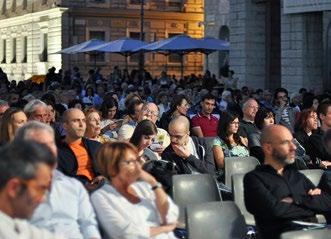

Trieste’s Film Festivals
attract visitors from all over the world. Trieste’s first movie theatre opened in 1905, only ten years after Lumière brothers’ first public screening.
from all over the world, as well as locals, who live and breathe the city’s undying love for cinema. Indeed, Trieste’s first movie theatre opened in 1905, only ten years after Lumière brothers’ first public screening.
September is the month of “I Mille occhi” [The thousand eyes, N/T] International Art and Film Festival, guiding visitors among the thousands of possible outlooks and itineraries telling the early history of cinema. Autumn provides a stage for the city’s Science+Fiction Festival, which rose from the ashes of the former Science fiction Festival (1963-1982) in 2000. It is now Italy’s main event devoted to science fiction, with high-profile guests, such as late Dutch Actor Rutger Hauer, unforgettable interpreter of Blade Runner’s self-aware android Roy Batty. This year’s Science+Fiction Festival will take place from 29th October to 3rd November.
For three decades now Trieste has been celebrating the new year with Trieste Film Festival. The Festival’s 31st edition will take place between 17th and 22nd January 2020, and it will pay homage to the voices of Central and Eastern European cinema further evidence of the city’s international dimension and East-West gateway role, offering a privileged observation point on this new side of European cinema.
ENGLISH TEXT
Le manifestazioni
–
richiamano appassionati dai cinque continenti. La prima sala cinematografica a Trieste fu aperta già nel 1905, appena dieci anni dopo la prima proiezione dei fratelli Lumière.
58 TRIESTE LIFESTYLE IES N°7 — September 2019 Città da vivere
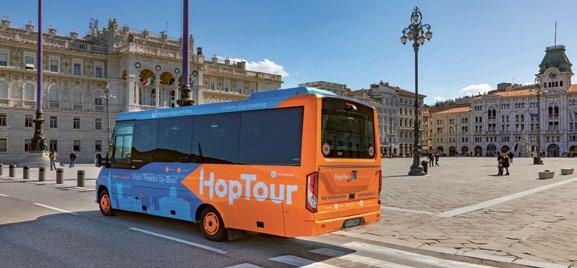
Il bus ‘Hop-on Hop-off’ è l’ideale per scoprire tutte le attrazioni turistiche di Trieste. /Hop-on Hop-off is the best way to discover all the tourist attractions of Trieste. Hop-on Hop-off Buy tickets online www.hoptour.it Info and Tickets +39 040 9720020 Booking point via Machiavelli 1, Trieste HopTour è promosso da /HopTour is promoted by Visit Trieste by Bus! 11€ 24hrs Ticket
DISHES & ROOMS AL PETES +CASA 903


Giovane, intraprendente e innamorato della sua città. Andrea Sinico, triestino classe 1988, tributarista di formazione, negli ultimi anni si è lanciato con impegno e passione nella carriera imprenditoriale, affiancato da un team di soci dinamico e coeso che comprende la madre e lo zio. In poco tempo è riuscito a vincere la sfida più grande: valorizzare la storia e la tradizione di Trieste offrendo servizi moderni e di qualità, rivolti ai residenti quanto ai turisti. La sua avventura inizia nel campo della ristorazione nell'ottobre 2012, con l'inaugurazione di “Al Petes” in via dei Capitelli 5/a, nella zona pedonale della cittavecchia, in pieno centro. Grazie alla preziosa collaborazione della sorella Giulia e dello Chef Marko Durdevic, alterna piatti della cucina locale a sfiziose sperimentazioni, il tutto innaffiato dall’ottimo vino delle migliori cantine del territorio. Nel 2017 amplia il numero di coperti, che tocca quota 120, in virtù dell’unione con la trattoria Antico Convento di sua proprietà. In estate i clienti possono godere della suggestiva terrazza all'aperto, immersa tra i resti romani della città. Menù e lista vini sono disponibili al sito www.al-petes.com.
Sette anni dopo, una nuova avventura. Ad aprile 2019, Andrea e Franco Bandelli, socio di Al Petes dal 2016, decidono di scommettere sul futuro turistico di Trieste con “Casa Novecentotre rooms & apartments”, in viale XX Settembre 25, in un palazzo risalente al 1870 e ampliato agli attuali quattro piani, come suggerisce il nome, nel 1903. La struttura, recentemente riammodernata dopo un anno e mezzo di lavori, ospita 24 stanze –di cui 8 con angolo cottura– comprensive di balcone privato, TV a schermo piatto, armadio, scrivania, bagno con bidet, aria condizionata e wifi. Ogni piano è dedicato a un aspetto tipico della città, con la presenza di foto, oggetti, quadri, ritratti e citazioni storiche: il primo è riservato al vento, la famosa Bora conosciuta in tutta Italia, e la Barcolana, la regata più partecipata al mondo che nel 2018 ha superato la “boa” delle cinquanta edizioni. Il secondo è riservato al caffè ed il suo storico legame con la città. Spazio allo sport al terzo, dove ad “accoglierli”, gli ospiti troveranno Nereo Rocco, Giuseppe Grezar, Gino Colaussi, Nino Benvenuti, Bruno Bianchi e tanti altri. Mentre al quarto troviamo la cultura e la tradizione letteraria, di cui Joyce, Svevo e Saba furono protagonisti. Casa Novecentotre gode della convenzione con lo storico Caffè San Marco per il servizio di colazione. A pochi passi dalle bellezze del centro, è ottimo per soggiorni brevi all'insegna del comfort. La reception è aperta dalle 9 alle 12 e dalle 15 alle 20.
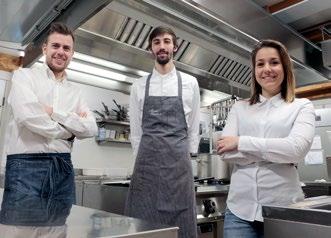
Info e prenotazioni www.casa903.it
60 TRIESTE LIFESTYLE IES N°7 — September 2019 Città da gustare
Young, proactive and in love with his city. Andrea Sinico, Triestine born in 1988, tax manager, has lately decided to start his own business with a dynamic and cohesive team including his mother and his uncle. In a short time he has won the toughest challenge: highlight Trieste’s history and tradition by offering modern and quality services for both locals and tourists. His adventure started in the restaurant business in October 2012, with the opening of “Al Petes” in via dei Capitelli 5/a, in the Old Town pedestrian area, right in the city centre. Thanks to the precious collaboration of her sister Giulia and of Chef Marko Durdevic, the restaurant offers both traditional dishes and intriguing fancy dishes, accompanied by excellent wine from the best wineries of the territory. In 2017 he increased the number of seats to 120, owing to the merger with the Trattoria Antico Convento, he owned. In summer, clients can enjoy their meal on the charming open terrace, surrounded by the city’s Roman ruins. Menu and wine list are available at www.al-petes.com.
Seven years later, a new adventure: in April 2019, Andrea and Franco Bandelli, partner of Al Petes since 2016, decided to bet on tourism in Trieste with “Casa Novecentotre rooms & apartments”, in Viale XX Settembre 25, in a historical building dating back to 1870 and enlarged to 4 stories in 1903, as its name suggests. The facility, recently refurbished after one and a half years of works, accommodates 24 rooms – eight of which with kitchenette – with private balcony, flat screen TV, wardrobe, desk, bathroom with bidet, air conditioning and Wi-Fi. Every floor is dedicated to a typical aspect of the city, with pictures, objects, paintings, portraits and historical quotes: the first is dedicated to the wind, the famous Bora known all over Italy and the Barcolana, the most crowded sailing race in the world that in 2018 celebrated its 50th edition. The second is dedicated to coffee due to its historical bond with the city. Sport is the theme on the third floor where you are “welcomed” by Nereo Rocco, Giuseppe Grezar, Gino Colaussi, Nino Benvenuti, Bruno Bianchi and many other famous sports people from Trieste. On the 4th floor you’ll find culture and literature with Joyce, Svevo and Saba. Casa Novecentotre relies on the partnership with the historical San Marco Café for breakfast. Just a few steps away from the city centre, it is the right place for a short comfortable break. Reception desk is open from 9 to 12 and from 15 to 20.

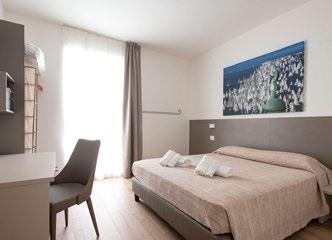
ENGLISH TEXT
61 TRIESTE LIFESTYLE IES N°7 — September 2019 Taste the city
WINE TOURISM
Nel 2020 centinaia di tour operator, giornalisti e stakeholder provenienti da tutto il mondo, parteciperanno a conferenze, workshop e degustazioni alla scoperta del patrimonio enogastronomico regionale.
Hundreds of the world’s most significant tour operators, reporters, and stakeholders, will gather in 2020 for conference meetings, workshops, and tastings events to discover this region’s food & wine traditional heritage.

–
62 TRIESTE LIFESTYLE IES N°7 — September 2019 Città da gustare
Trieste capitale mondiale del turismo enogastronomico. Almeno per tre giorni, dal 24 al 26 marzo del prossimo anno, saranno puntati sul capoluogo giuliano gli occhi dei maggiori esperti e responsabili del turismo legato a cibo e vino.
L’occasione è la 12a edizione dell’International Wine Tourism Conference (IWINETC), il più importante evento internazionale per l’industria del turismo enogastronomico, che vedrà riuniti centinaia di tour operator, giornalisti e stakeholder internazionali provenienti da tutto il mondo, che parteciperanno a conferenze, workshop, degustazioni e itinerari alla scoperta del patrimonio enogastronomico regionale.
Trieste e il Friuli Venezia Giulia sono stati scelti al termine di visite che il board organizzativo dell’IWINETC ha fatto nelle località che si erano candidate a ospitare la conferenza, per l’ospitalità ricevuta, per la conformità delle strutture ricettive e congressuali, per la garanzia di ricevere da PromoTurismoFVG tutto il supporto logistico e organizzativo necessario e, non ultimo, l’ascesa della destinazione come meta per il turismo enogastronomico.
Fondata in Spagna nel 2009, la conferenza si tiene infatti ogni anno in destinazioni in ascesa per il turismo enogastronomico, come ad esempio Porto, Tbilisi, Champagne, Barcellona e i Paesi Baschi, sede dell’edizione 2019 dove PromoTurismoFVG ha raccolto il testimonial virtuale dalla città di Vitoria-Gasteiz.
La scelta di svolgere l’edizione 2020 dell’ IWINETC in Friuli Venezia Giulia –spiega PromoTurismoFVG– rappresenta per la regione un’ulteriore conferma che le strategie portate avanti in questi anni per valorizzare l’offerta enogastronomica, unita al turismo e, in questo caso, al congressuale, sta portando grandi risultati. [CDL]
Trieste as world capital of wine tourism. In 2020, from 24th to 26th March, the world’s main food & wine experts in the world will turn their gaze to this city.
Indeed, in 2020 Trieste will host the 12th edition of the International Wine Tourism Conference (IWINETC), the most important international event for the industry of food & wine tourism, gathering hundreds of the world’s most significant tour operators, reporters, and stakeholders, for conference meetings, workshops, tastings, and itineraries through this region’s food & wine traditional heritage.
After visiting all hosting contenders, IWINETC’s board selected Trieste and the region of Friuli Venezia Giulia for their hospitality and high-level accommodation and congress centres, as well as for the logistic and organisational support that will be provided by PromoTurismoFVG, and –last, but not least– the area’s recent success as food & wine tourist destination.
Founded in 2009 in Spain, IWINET’s yearly Conference takes place in emerging wine-tourism destinations, such as Porto (Portugal), Tbilisi (Georgia), the Champagne wine region (France), Barcellona (Spain), and the Basque Country, host of 2019 IWINETC, where PromoTurismoFVG won the virtual endorsement of the capital, Vitoria-Gasteiz.
According to PromoTurismoFVG, being selected for IWINETC’s 2020 edition attests to the success of the strategies implemented in the past few years to promote the local food & wine offer, especially in the tourism and congress sector.

ENGLISH TEXT
63 TRIESTE LIFESTYLE IES N°7 — September 2019 Live the city
RUSSIZ SUPERIORE COLLIO
Un universo policromo fatto di sapori, identità e storie personali. Emozioni e racconti che si susseguono e si differenziano nella denominazione Collio: morbide colline, vocate da sempre alla produzione di vini bianchi di qualità.
Riconosciute fin dal Medioevo come le più pregiate, le uve a bacca bianca sono il frutto di una perfetta combinazione di microclima e terreno, di origine eocenica composto da marne e arenarie su cui Roberto Felluga assieme ai suoi collaboratori, scrive ogni giorno la storia dei propri vini delle cantine Marco Felluga e Russiz Superiore.
Il Pinot Grigio ed il Sauvignon, uve coltivate nella denominazione Collio già dalla seconda metà del 1800, hanno trovato in questa denominazione, l’habitat e le condizioni ideali per divenire eccellenza. Coltivati diffusamente anche in altri Paesi, il Pinot Grigio e il Sauvignon si pongono come protagoniste di questa terra e consentono un importante confronto internazionale. Degustandoli anche dopo molti anni, continuano ad esprimere una notevole evoluzione, regalando freschezza, corpo, equilibrio, complessità e spessore.
Vini espressione di grande struttura, carattere ed eleganza, come dimostrano il ‘Collio Pinot Grigio Mongris Riserva’ e il ‘Collio Sauvignon Riserva’.
Un vero e proprio viaggio che consente di scoprire l’evoluzione del tempo, l’immutata qualità –garanzia del Collio– e la consapevolezza di avere a disposizione un patrimonio innato per produrre grandi vini bianchi da invecchiamento.
ENGLISH TEXT
Amultifaceted universe of flavours, identities, and personal stories. Emotion and tale follow one another, their distinct character preserved in one name, Collio: a land of gentle slopes with a propensity for the production of high-quality white wine. As witnessed by their reputation for fineness dating back to the Middle Ages, local white-grape vines are the result of the perfect combination of microclimate and marl- and sandstone soil – a soil, whose layers are pages of a journal, where Roberto Felluga and his collaborators write the everyday story of the Marco Felluga and Russiz Superiore’s wines. Pinot Grigio and Sauvignon grape varieties, belonging to the Collio designation since the second half of the 19th century, have found their ideal habitat here, as well as conditions to become a local excellence. Grown around the globe in various ways, local Pinot Grigio and Sauvignon distinguish themselves at international level for their unique characteristics. Their resulting wine varieties age distinctly well, preserving freshness, body, balance, complexity, and texture even after many years.
Wines of character and style – witness ‘Collio Pinot Grigio Mongris Riserva’ and ‘Collio Sauvignon Riserva’.
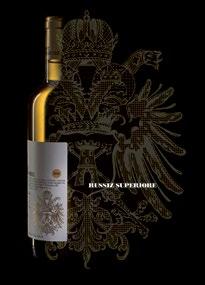
A journey through centuries of unaltered quality –a Collio guarantee– and the awareness of a unique opportunity, resulting from an extraordinary heritage of ideal resources to produce great white wines for ageing.
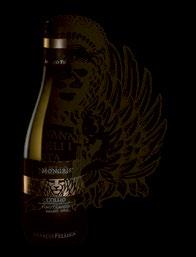
64 TRIESTE LIFESTYLE IES N°7 — September 2019 Città da gustare
NO BORDER FOOD
Gusto, olfatto e istinto. Sedersi a tavola è sufficiente per rendersi conto di quanto Trieste sia una meravigliosa, singolare anomalia geografica e storica. È il cibo –al pari di un buon libro– a raccontare la sua storia fatta di influenze culturali le più disparate. Pranzare con uno spaghetto allo scoglio bevendo un bicchiere di vino del territorio e in seguito cenare a salsicce e crauti sorseggiando una birra –questo senza mai uscire dalla tradizione culinaria locale– non è cosa da poco.
Del resto Trieste è al tempo stesso l’estremità più a nord del Mediterraneo e la rappresentazione più meridionale della cultura continentale europea. L’ Impero Austro-Ungarico, le generazioni di commercianti greche, turche ed ebraiche attratte dalle potenzialità del suo porto e la vicinanza alle culture balcaniche dell’ex-Jugoslavia sono fra le ragioni principali del suo incredibile meltin’ pot gastronomico.
Piatti come il goulash (spezzatino di origine ungherese), il kaiserfleisch (maiale affumicato di derivazione austriaca),
la caldaia triestina (celebrazione della carne di maiale bollita servita nei tradizionali buffet) o la calandraca (etimologia greca per una sorta di stufato di carne e patate), se affiancati a una altrettanto ricca tradizione di pesce, sono motivazioni più che sufficienti per far dire alla ristoratrice Ami Scabar in “Trieste la città dei venti”, scritto insieme allo scrittore Veit Heinichen, “Quale altro porto del sud ha sviluppato una cucina di carne così variegata come questa città?”. E di carne vogliamo parlarvi, focalizzandoci –altrimenti non basterebbe un’intera rivista– su alcuni piatti cotti alla brace emblematici della tradizione balcanica, che Trieste ha adottato e fatto suoi.
Difficile non cominciare dai ćevapčići, che i triestini amorevolmente abbreviano in “civa”. Lo scrittore serbo Nusič li vorrebbe apparsi per la prima volta a Belgrado intorno al 1860 ma sono stati i Turchi –grandi cultori della carne alla brace– a portarli nei Balcani durante l’occupazione ottomana. L’etimologia infatti arriva da “kebab” a cui si attacca la radice slava “-čiči”. Piccoli salsicciotti di carne macinata mista di manzo, maiale, agnello o montone (a seconda delle aree geografiche). Vengono cotti alla brace e
serviti con cipolla cruda e ajvar (salsa a base di peperoni). In Bosnia e Serbia invece si servono tradizionalmente come street food dentro ai somun, piccole forme di pane imparentate con le “pita” turche, e con il kajmak (un formaggio fresco non dissimile allo jogurt).
Se siete alla ricerca di deliziosi spiedini di carne Trieste vi risponde con i ražniči, piatto tradizionale serbo diffuso in tutti i Balcani. Come per i ćevapčići, con i quali molto spesso vengono serviti, l’origine storica è da ricercarsi in Turchia e sono sicuramente imparentati anche con il souvlaki Greco. La carne è di maiale inframmezzata da peperoni e cipolle grigliate. Spostandovi nei Balcani spesso la carne diventa di pecora o agnello. Anche in questo caso la salsa da abbinare è l’ajvar.
La pljeskavica (si pronuncia “plièskaviza”) è la risposta balcanica all’hamburger. La parentela con i “civa” e i ražniči è stretta e anzi l’impasto è simile se non identico a quello dei ćevapčići, a cui viene aggiunto del bianco d’uovo per tenere insieme la carne. Originariamente di Leskovac in Serbia, è interessante l’etimologia del nome: la parola “pljiesak” significa letteralmente “sbattere le mani”
di /by Alice Fabi
65 TRIESTE LIFESTYLE IES N°7 — September 2019 Taste the city
ovvero applaudire. È infatti sbattendo forte tra le mani la carne macinata che si ottengono questi burger molto più sottili del normale, che a Trieste si mangiano nelle grigliate miste insieme a cipolla cruda e ajvar ma che nei Balcani diventano veri e propri panini, serviti dentro una particolare sorta di pita detta “lepinja”.
ENGLISH TEXT
Tastes, scents, and instinct. You only need to sit down for a meal to realise that Trieste is a wonderful, peculiar anomaly of geography and history. Trieste’s food, like a good book, tells a tale of most diverse cultural influences. Take a lunch of spaghetto allo scoglio [spaghetti with seafood] sipping local wine and a dinner of salsicce e crauti [sausages and sour krauts] washed down with a cold beer: two different mouth-watering experiences, yet two recipes belonging to one single culinary tradition.
After all, Trieste is both the northernmost point of the Mediterranean Sea and the southernmost stronghold of Europe’s continental culture. The Austro-Hungarian Empire, together with generations of Turkish, Greek, and Jewish merchants, drawn to this city by the potential of its harbour, right on the border with the Balkans these are the main factors contributing to Trieste’s unparalleled melting-pot cuisine.
Dishes like goulash (a Hungarian soup of seasoned meat and vegetables), kaiserfleisch (smoked pork meat of Austrian origin), caldaia triestina (a traditional main course served in local buffets made of boiled pork meat), or calandraca (a term of Greek origin indicating a type of meat stew served with potatoes), together with an equally impressive seafood tradition, are enough to earn Trieste the words written by restaurant owner Ami Skabar in the book “Trieste – City of winds”, co-authored by writer Veit Heinichen: “What other southern port has developed such a multifaceted tradition of meat cuisine as this city?”. And meat is precisely what the paragraphs that follow are about: char grilled dishes of Balkan tradition adopted and re-interpreted by Trieste’s cuisine here we selected only the most emblematic ones, as an entire issue of IES magazine would not be enough to mention them all.
It is only proper, then, to start with ćevapčići, which Triestini affectionately call “civa”. Serbian essayist and novelist Branislav Nušić claims that they were first created in Belgrade around 1860, but it was actually during Ottoman
occupation that ćevapčići first reached the Balkans thanks to the Turks great connoisseurs of char-grilled meat. Indeed the term originates from the word kebab, with the addition of the Slavic suffix “-čići”. Ćevapčići are little sausages of a mixture of minced meat that includes beef, pork, lamb, or mutton, depending on the geographical area. They are char grilled and served with raw onion and ajvar (pepper-based sauce). Elsewhere, in Bosnia and Serbia, they are considered street food and are served in a somun, small portion of flatbread resembling Turkish pita bread with a side of kajmak (creamy cheese made of fresh milk, not dissimilar to clotted cream).
If you have a crave for mouth-watering meat skewers, Trieste will serve you ražnjići , main course of Serbian tradition very popular throughout the Balkans. Like ćevapčići, which are frequently served in the same course, ražnjići have their roots in Turkish cuisine and are most certainly akin to Greek souvlaki. They are made of pork meat cooked on a skewer with grilled peppers and onions. In the Balkans pork is frequently replaced with sheep or lamb meat. Here, too, the accompanying sauce is ajvar.
Pljeskavica (pronunciation: “plièskavitsa”) is the Balkan version of a hamburger. It is closely related to both civa and ražnjići, as it is made of the same kind of meat, which is minced, mixed with egg whites, and then worked into patties. Pljeskavica recipe is believed to originate from Leskovac, Serbia. Their name has a rather peculiar meaning: it comes from the word “pljesak”, namely clapping one’s hands together when applauding. Indeed, this is how a meat patty is made, clapping one’s hands together around the meat cake until it turns into a very thin hamburger. In Trieste they are served in mixed grilled courses with a side of raw onions and ajvar, while in the Balkans they are used as fillings for lepinja, a local pita-like flatbread.
–
L’Impero AustroUngarico, le generazioni di commercianti greche, turche ed ebraiche sono fra le ragioni dell’incredibile meltin’pot gastronomico di Trieste.
The Austro-Hungarian Empire, together with generations of Turkish, Greek, and Jewish merchants, are the main factors contributing to Trieste’s unparalleled melting-pot cuisine.
66 TRIESTE LIFESTYLE IES N°7 — September 2019 Città da gustare

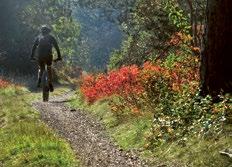







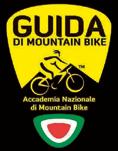


TOP FIVE
Rustiko
Sasha Mitic è il nome da tenere presente per assaggiare piatti tipici della cultura Serba in città. Il suo “Rustiko” in Via Madonnina 19/a è la destinazione per ćevapčići, pleskavice ed altre delizie Serbe, dal burek (con carne o formaggio), ai sarma (involtini di carne e riso avvolti in una foglia di cavolo). Da lui potete assaggiare il panino di “civa” fatto con la lepinja che ha vinto pure un premio come miglior street food nel 2015. D'estate il locale apre una “succursale” anche a Barcola sul mare.
Sasha Mitic is your man if you are looking for authentic Serbian cuisine in Trieste.


His Rustiko restaurant is located at no. 19/a of Via Madonnina, where guests can taste delicious ćevapčići and pljeskavica, together with further Serbian delicacies, such as burek [pastries made of flaky phyllo dough, N/T] (with either meat or cheese filling), sarma (cabbage leaves stuffed with rice and minced meat). Here you can taste the civa sandwich, made of lepinja bread, and winner of the 2015 award for best street food. Rustiko has a summer branch in Barcola, right on the seaside.
La Bajta
La Fattoria Bajta a Sales alleva allo stato brado i propri maiali. La carne la potete acquistare nel loro spaccio –ad esempio se state organizzando una grigliata a casa e volete fare davvero bella figura– insieme alla loro produzione di salumi e a carne di manzo e di pollo (questi provenienti da altri allevamenti locali) di altissima qualità. Ma la Bajta chiude il cerchio con il suo agriturismo, perciò oltre a comprare la carne prenotate, sedetevi e ordinate una grigliata cotta alla brace. C'è di che leccarsi i baffi.

Fattoria La Bajta in Sales farms only free-range pigs, whose meat can be purchased at La Bajta’s outlet, together with the farm’s own production of cured meat, and a selection of third-parties’ beef and chicken meat. In other words, La Bajta is your destination if you plan to host a Sunday barbecue and wish to really impress your guests. There is even a holiday farm, where you can sit down and enjoy a delicious char-grilled lunch.
Fast Food Jufi
Altra destinazione immancabile per chi punta a un'esperienza gastronomica serba ma soprattutto a gigantesche e sottili pleskavice come da tradizione, servite nelle lepinje. Si trovava in zona defilata fuori dal centro ma adesso si è spostato in Via Genova, a due passi dalla Chiesa Serbo-Ortodossa e Ponte Rosso. È il locale più centrale di tutti, l'ideale per un pasto veloce se siete in città. Oltre alla pljeskavica assolutamente da provare sono i ražnjići e non mancano deliziosi ćevapčići
Serbian cuisine enthusiasts would never want to miss Jufi’s huge and yet impossibly thin pljeskavica served in lepinja bread, according to the true traditional recipe. Jufi’s kitchen used to be located in the city otuskirts, but has recently moved to Via Genova, a stone’s throw away from Saint Spyridon Serbian Orthodox church and Ponte Rosso. This new central location is perfect for a quick meal in the city centre. Do not forget to have a taste of Jufi’s delicious ražnjići and ćevapčići.
Trattoria Gelmo

Il Sig. Gelmo ha fondato questa trattoria a conduzione familiare nel 1927 e oggi i nipoti ne continuano la tradizione. Accanto a piatti tipici come gli gnocchi fatti in casa con il goulasch e la ljubljanska (la milanese con prosciutto e formaggio) c'è la carne alla griglia, assolutamente da provare. Le grigliate miste includono ottime pleskavice da gustare con la cipolla cruda e l’ajvar. Si trova un pò fuori dal centro in Strada di Fiume non lontano dall'ospedale di Cattinara.
Mr Gelmo started his family business in 1927, and today his grandchildren follow in his steps. They serve traditional dishes, such as handmade gnocchi with goulash and ljubljanska (Viennese-style cutlets not dissimilar to schnitzel, usually breaded and with ham and cheese stuffing), but also a fine selection of grilled meat. Mixed grill dishes include excellent pljeskavica served with raw onion and ajvar. Trattoria Gelmo is located in Trieste’s suburban area, on Strada di Fiume, on the way to Cattinara central hospital.
68 TRIESTE LIFESTYLE IES N°7 — September 2019 Città da gustare
Le Sagre
Parlando di ćevapčići, ražnjići e pleskavice è impensabile non citare le sagre rionali, che a Trieste sono diffuse su tutto il territorio (sia in città ma soprattutto sull'altipiano) e sono il regno della carne alla griglia. D'estate, il triestino che si rispetta non può mancare almeno una tappa in sagra, è come andare in osmiza. La sagra è sinonimo di grandi mangiate di ćevapčići, ražnjići, polletti alla griglia e pleskavice bevendo fiumi di birra e ballando canzoni popolari. I proventi vanno spesso ad associazioni sportive o alla comunità locale, che le organizzano. Oltre alla pancia piena ed all'esperienza tipica quindi, anche la buona azione.
Ćevapčići, ražnjići, and pljeskavica feature invariably in local sagre rionali traditonal festivals of city neighbourhoods, both in Trieste and the surrounding areas (especially on the Karst plateau) the true kingdom of grilled meat. A true Triestino attends at least one sagra per summer, it is a tradition, like osmiza trips. Sagra means hearty meals of ćevapčići, ražnjići, grilled chicken, and pljeskavica, washed down with rivers of beer, and accompanied by folk songs and dances. Returns are usually devolved to sport associations or the local community. A full stomach, a unique experience, and a good deed, all in one go.
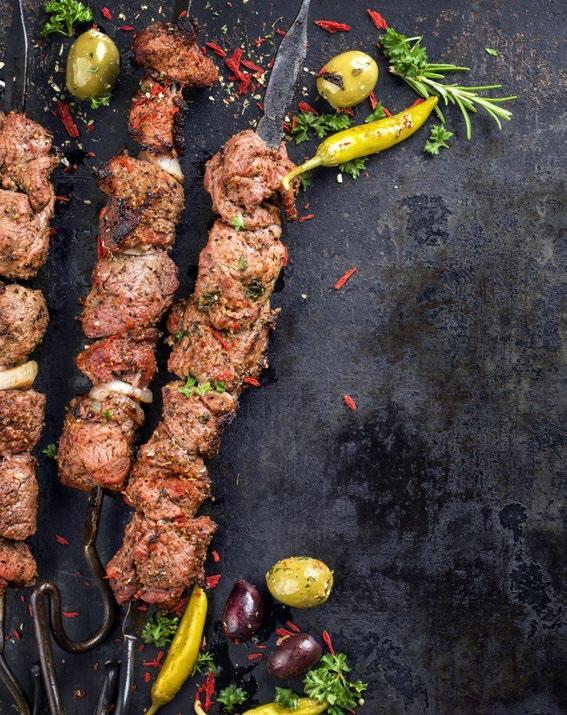
69 TRIESTE LIFESTYLE IES N°7 — September 2019 Taste the city
 Via San Sebastiano, 1 Trieste - T +39 040 632191
Via Caboto / angolo Via Malaspina, 1/1 Trieste - T +39 040 827431
c/o PORTOPICCOLO, Sistiana 231/Q9 T +39 040 9976625
Via San Sebastiano, 1 Trieste - T +39 040 632191
Via Caboto / angolo Via Malaspina, 1/1 Trieste - T +39 040 827431
c/o PORTOPICCOLO, Sistiana 231/Q9 T +39 040 9976625
BENESSERE ESCLUSIVO
The Med in Blue unit of measure is beauty: which derives from the wonderful Gulf of Trieste, and the beneficial effects of its pristine nature, amplified by the results of medical research and aesthetic research.
Unità di misura di Med in Blue Medical Spa è la bellezza: arriva direttamente dalla meraviglia del Golfo di Trieste e, con gli influssi benefici di un ambiente incontaminato, amplifica gli effetti della ricerca medica ed estetica.
Partendo dall’incontro sinergico tra scienza e natura, nella dimensione di raffinata ospitalità del complesso di lusso di Portopiccolo, Med in Blue, la nuova Medical SPA, ha creato il contesto perfetto in cui riscoprire l’essenza di sé per tracciare un nuovo futuro.
Uno spazio di relax e tranquillità, preziosamente protetto, dove il benessere prende forma attraverso un approccio olistico della Portopiccolo SPA by BAKEL alla diagnosi e ai trattamenti, fortemente orientato alla concretezza del risultato. L’identificazione dei fattori che sono intimamente connessi con la longevità dà forma alla ricerca. L’obiettivo? Strutturare le basi di una durevole qualità di vita attraverso un’esperienza autenticamente esclusiva, per trovare l’equilibrio psicofi ico ideale. E iniziare un nuovo percorso di rigenerante armonia, partendo dalla conoscenza del vostro corpo. In un
contesto straordinario come Falisia, a Luxury Collection Resort & SPA all’interno del complesso di lusso di Portopiccolo. In questo anfiteatro naturale, affacciato sul Golfo di Trieste, è nata la Med in Blue Medical SPA: uno spazio aureo, con una gamma di trattamenti unica in Europa, in cui applicare i risultati della ricerca sulla longevità che combina analisi della fisiologia del corpo e indagini genetiche e metaboliche, mettendo a punto programmi personalizzati al rallentamento dei processi di invecchiamento, alla riduzione dei fattori che mettono in sofferenza l’organismo e all’identificazione di un migliore lifestyle

Per godere pienamente della gioia di vivere.
Starting from the synergetic fusion of science and nature, amid the refined hospitality and luxury of the Portopiccolo complex, Med in Blue, the new Medical SPA, has created the perfect environment for you to rediscover yourself and plan a new future. A protected space of relaxation and tranquillity, where wellbeing develops through a results-oriented, holistic approach by Portopiccolo SPA by BAKEL to diagnosis and treatment. Identifying factors closely related to longevity is an integral part of research, and aiming to create the foundations of your longevity, allowing you to find the ideal psychophysical balance through an authentic and exclusive experience. Starting a new harmony-regenerating process, beginning from knowing your own body. In an extraordinary place like Falisia, a Luxury Collection Resort & Spa within the Portopiccolo luxury complex in this natural amphitheatre on the Gulf of Trieste where Med in Blue was born: a golden section, with a unique range of treatments in Europe, where the longevity research results are applied combining analysis of body physiology with genetic and metabolic exams, defining programs aimed at delaying the ageing process, reducing body stress factors and identifying a better lifestyle.
Bringing you to a new state of wellbeing and enabling you to enjoy life to the full.

ENGLISH TEXT
Info medicalspa@falisiaresort.com tel: +39
71 TRIESTE LIFESTYLE IES N°7 — September 2019 Agenda
040 291291
La regata di Dee Caffari –Dee Caffari’s regatta
Barcolana 51 avrà come testimonial la prima velista ad aver navigato in solitario intorno al mondo e skipper di “Turn the Tide on Plastic” nella Volvo Ocean Race 2017/2018, l’inglese Dee Caffari. Barcolana ha scelto Dee per il suo impegno nei confronti della sostenibilità ambientale, per la sua passione genuina e perché rappresenta un modello da seguire per le giovani donne, dimostrando che lo sport della vela è fonte di molte opportunità di crescita personale.
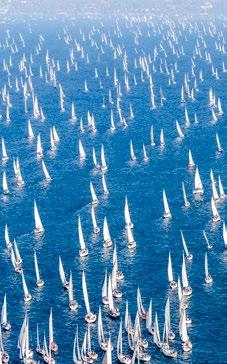
“Sono stata fortunata –dice Dee Caffari– ad avere la velista triestina Francesca Clapcich nell’equipaggio dell’ultima Volvo Ocean Race. Avevo sentito parlare di questo evento ma è stata ‘Frankie’ a farmi conoscere la Barcolana e non vedo l’ora di partecipare a questa manifestazione con vero spirito sportivo. Il mio obiettivo nel corso della Barcolana sarà quello di aumentare la consapevolezza ambientale e ispirare le nuove generazioni, sensibilizzare sul tema sia la comunità velica sia gli amanti dell’oceano in generale. Voglio anche aumentare l’attenzione sul tema dell’inquinamento oceanico causato dalle plastiche a tutti coloro che

BARCOLANA 50+1
72 TRIESTE LIFESTYLE IES N°7 — September 2019 Agenda
parteciperanno alla Barcolana. So che lo scorso anno sono stati fatti notevoli progressi sul tema, ma rimane molto da fare per salvare i nostri oceani e ridurre l’utilizzo delle plastiche monouso nella nostra quotidianità è un passo fondamentale verso questo obiettivo. “Ispirazione” è un altro concetto chiave. Credo che la vela abbia molto da offrire alle veliste e spero che partecipare alla Barcolana mi permetterà di condividere le mie esperienze e ispirare le donne a fare questo sport.”
ENGLISH TEXT
The 51 st edition of Barcolana will be endorsed by British sailor Dee Caffari, first woman to sail single-handedly and non-stop around the world, as well as the leading skipper of the “Turn the Tide on Plastic” sailing team during the 6th edition of Volvo Ocean Race in 2017-2018. Dee was selected for her commitment to environmental sustainability, her genuine passion, and her inspiring endeavours, which have turned her into a role model for young women throughout the world, showing how sailing may offer invaluable opportunities of personal growth.
“I was lucky to be in the same team as Trieste’s sailor Francesca Clapcich during last year’s Volvo Ocean Race she comments I had heard about Barcolana before, but it was only thanks to ‘Frankie’ that I finally learned about it, and I am really looking forward to being a part of it and breathing in its unique atmosphere. Barcolana will be the perfect opportunity for me to raise awareness about the environment and inspire new generations of sailors and ocean lovers in general. More specifically, my goal is to focus everyone’s attention on the growing issue of plastic pollution of the oceans. I am aware of the strong message conveyed during last year’s Barcolana and the progress made, but there is still a long way to go to save the oceans we love. A crucial step forward is reducing the use of single-use plastic in everyday life. ‘Inspiration’ is also a key concept: I believe that sailing has a lot to offer, especially to women. I hope that, by taking part in this year’s Barcolana, my own experience may inspire other women and bring sailing closer to them.”
Barcolana aggiunge un “+1” all’edizione 50 e punta a parlare di mare e ambiente. L’edizione del cinquantesimo è entrata nel Guinness dei primati come “the largest sailing race in the world”, e lo studio realizzato a febbraio sull’impatto economico della manifestazione ha evidenziato un ritorno per Trieste e il territorio superiore ai 70 milioni di euro. Ora guardiamo oltre i numeri, in questa edizione puntiamo alla soddisfazione e alla gioia dei partecipanti a terra e in mare. Vogliamo concentrarci sulla sostenibilità ambientale dell’evento anche in termini di pressione sul Golfo, e ci poniamo l’obiettivo di migliorarci dal punto di vista organizzativo, in relazione agli spazi che abbiamo a disposizione per gli ormeggi e in relazione agli investimenti che, insieme alle istituzioni, saremo in grado di fare per garantire la miglior partecipazione.

Barcolana adds “+1” to last year’s 50th edition and focuses on the environment and the sea. Barcolana’s 50th edition entered the Guinness World Records list as the largest sailing race in the world, with an economic return of over 70 million Euros for Trieste and its territory, according to an impact study carried out in February 2019. Today we look forward, beyond numbers, to ensure satisfaction of participants, both on land and at sea. We want to focus on the event’s environmental sustainability, first and foremost as regards the Gulf of Trieste. Our goal is to improve organisation in terms of available mooring space and in terms of investments, which, together with local institutions, we will devote to our efforts to ensure optimal participation.
Mitja Gialuz
Mare e ambiente
“Voglio aumentare la consapevolezza ambientale e l’attenzione sul tema dell’inquinamento oceanico causato dalle plastiche.”
–
73 TRIESTE LIFESTYLE IES N°7 — September 2019 Agenda
“I want to raise awareness about the environment and my goal is to focus everyone’s attention on the growing issue of plastic pollution of the oceans.”
/by Nicolò Giraldi Agenda
FUORI PORTA È
BEETHOVEN A MUGGIA
di IES N°7 — September 2019
a poco meno di venti chilometri da Trieste la più grande collezione privata di testimonianze storiche legate a Ludwig van Beethoven. È una storia nascosta, rimasta per certi versi nell’oblio per troppo tempo, ma che negli ultimi anni è riemersa con forza, regalando una possibilità unica ai visitatori di ascoltare le storie legate a uno dei maestri della musica classica di tutti i tempi.
La collezione è di proprietà della famiglia Carrino che, in oltre 40 anni, ha raccolto in tutto il mondo una mole di materiale enorme, con più di diecimila oggetti che si possono ammirare nella casa-museo della località rivierasca. La particolarità sta nel fatto che in nessun altro luogo del pianeta si trovano così tanti elementi legati a doppio filo a Beethoven, in un’atmosfera da collezionismo che testimonia la caratterizzazione positiva di una splendida mania.
Ci sono sculture del Mascherini, ritratti di Riedel, oltre 4500 scritti dedicati al compositore, l’annuncio mortuario della pagina Berliner Allgemeine pubblicato l’11 aprile 1827, giorno del suo decesso; si cammina tra la prima partitura della famosissima V Sinfonia, pubblicata a Lipsia nel 1826, migliaia di francobolli dedicati e un’atmosfera da sogno impreziosita dal racconto dei coniugi Sergio e Giuliana i quali, neanche farlo apposta, hanno chiamato loro figlio proprio come Beethoven.
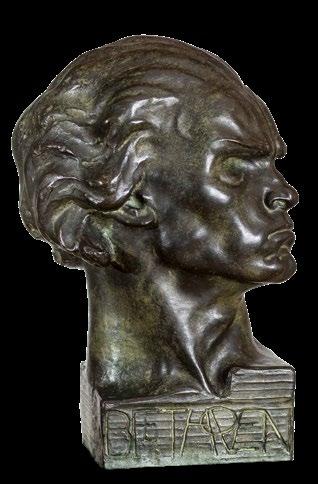
Michael Ladenburger, direttore del Museo di Beethoven di Bonn, città natale del compositore, ha un debole per i Carrino. “Questo posto non ha eguali al mondo” ha detto in più occasioni. E la sensazione è esattamente quella sintetizzata dalle sue parole. Un mondo dimenticato e poco conosciuto, ma che fornisce ancora una volta, la dimostrazione di come l’amore verso la Storia dei cittadini nati e cresciuti su questo lembo di terra, possa tramutarsi in un’occasione unica di divulgazione e, per questo, essere riconosciuto come autentico privilegio. Purché venga condiviso. Info vb@bibliotecabeethoveniana.it 74 TRIESTE LIFESTYLE
Ashort drive about 20 km outside Trieste will lead you to the largest private collection and testament to the life and work of Ludwig van Beethoven. These invaluable fragments of a long forgotten, almost concealed side of history, resurfaced just a few years ago. Visitors have now the unique privilege of learning about so far unshared stories revolving around one of the greatest masters of classical music of all times.
This collection belongs to the Carrino family, who spent the past 40 years travelling the globe to collect these inestimable items and acquiring a huge amount of material in the process more than ten thousand pieces, that are now displayed in the family’s residence, now also a home-museum called Biblioteca Beethoveniana, in the tiny sea town of Muggia. Nowhere else in the world so many testimonies of Beethoven’s life and work are gathered in one single place, and all the merit goes to the Carrino’s collector’s spirit evidence of how a harmless obsession may be turned into a splendid gift to the world. There are Mascherini’s sculptures, Riedel’s portraits, more than 4,500 written documents about the famous


composer, and even the obituary published in the German newspaper Berliner Allgemeine Zeitung on 11th April 1827, the day of his death. You can let your gaze wander over the first draft of Symphony No. 5 in C minor and the dedicated series of limited edition stamps, while listening to Sergio and Giuliana, husband and wife, whose tales are as precious as the items they own and whose son was named after Beethoven himself.
Michael Ladenburger, director of memorial site, museum and cultural institution Beethoven Haus in Bonn (Beethoven’s birthplace), has a fondness for the Carrinos and often remarks that “there is no place like this [the Carrino’s museum, N/T] in the whole world”. Ladenburger’s words quite aptly summarise the feeling inspired by a visit to the Biblioteca Beethoveniana a little known, almost forgotten world, saved from oblivion only thanks to the love for History of the people born and raised here, on this strip of land. A world that has now turned into a unique opportunity for knowledge dissemination an authentic privilege, provided it is shared.
ENGLISH TEXT
In nessun altro luogo del mondo si trovano così tanti elementi legati a Beethoven.
–
75 TRIESTE LIFESTYLE IES N°7 — September 2019 Agenda
Nowhere else in the world so many testimonies of Beethoven’s life and work are gathered in one single place.
GRADO & LIGNANO CHALLENGE

Prospettive inedite, dettagli nascosti, momenti vita sulla spiaggia, particolari di un momento di sport: sono 2.874 che i turisti hanno pubblicato su Instagram usando l'hashtag #gradochallenge (1.399) o #lignanochallenge (1.475) e inserendo il tag @FVGlive. Hanno partecipato così a una vera e propria sfida lanciata da PromoTurismoFvg per ”mettere in vetrina” le due perle della costa della regione, “viste con gli occhi dei turisti" Le foto sono state scattate fra il 22 luglio e il primo settembre e agli autori delle dodici foto più belle (sei per Grado e sei per Lignano) sarà ora offerta la possibilità di vivere un'esperienza “live like a local” a fianco di un ambassador del Friuli Venezia Giulia. Un successo, al punto che il prossimo challenger è già in calendario: la Barcolana 50+1 del 13 ottobre.
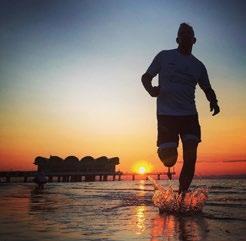
Unique perspectives, hidden details, moments on the beach or doing sport: these are the pictures that 2,874 tourists have published on Instagram using the hash tag #gradochallenge (1,399) or #lignanochallenge (1,475) and including the tag @FVGlive. In this way they have taken part in a true challenge organized by PromoTurismoFvg to “showcase” the two jewels of the Region’s coast, “seen through the eyes of a tourist”. The pictures were taken between 22 July and 1 September and the authors of the 12 best pictures (six for Grado and six for Lignano) will be offered the opportunity to “live like a local” next to an ambassador of Friuli Venezia Giulia. The competition has been a great success and there’s already another challenge: Barcolana 50+1 on 13 October.
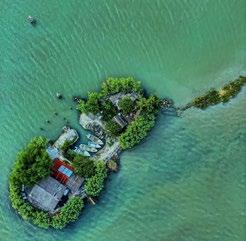
76 TRIESTE LIFESTYLE IES N°7 — September 2019 Agenda



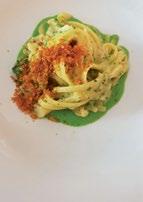
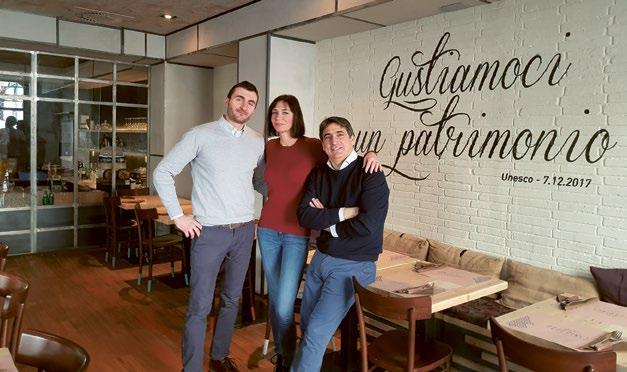
HOP TOUR POST-IT
Itinerari suggestivi tra il mare e le Alpi, per mettersi comodi e lasciarsi trasportare tra le bellezze storiche e naturalistiche del territorio.
Così l’agenzia Yes Tour, nata a Trieste nell’estate del 2018, ha conquistato turisti e residenti, riuscendo nella sfida di coniugare innovazione tecnologica e marketing. Le proposte sono diverse e dettagliate, personalizzabili in base alle esigenze di viaggio espresse dai clienti. Il percorso principale è il “Trieste HopTour”, in partnership con la Trieste Trasporti, alla scoperta del capoluogo giuliano attraverso i suoi luoghi più significativi: dal Molo Audace al Castello di Miramare, passando per il Borgo Teresiano, il Colle di San Giusto, Barcola e il Faro della Vittoria. Segue il tour transfrontaliero che tocca Lubiana, capitale della Slovenia, e l’affascinante Lago di Bled. E ancora la visita dei siti Unesco del Friuli Venezia Giulia, come Aquileia, Cividale e Palmanova. Tra le recenti sperimentazioni, avviate con successo, spiccano l’escursione alle Grotte di Postumia, le più visitate d’Europa, e gli itinerari guidati della Trieste asburgica e romana e del Castello di Miramare. Quest’ultimo include il ritorno via mare. A distanza di oltre un anno, il bilancio del fondatore e CEO Giampiero Campajola è positivo. I numeri parlano chiaro: dal 21 luglio 2018 alla stessa data del 2019 ben 12.950 persone hanno usufruito del servizio del tour cittadino. Dal 1 gennaio 2019 il numero di partecipanti ha già superato quota 11.000. Per scoprire le tappe dei percorsi, l’agenzia ha affiancato al sito web www.yestour.it l’app AroundTrieste, disponibile su Ios e Android. A luglio 2019 è stato inaugurato un primo punto informativo nel pieno centro cittadino, in via Trento 1.

Charming itineraries between the sea and the Alps, just relax and enjoy the historical and natural beauties of the territory. The travel agency Yes Tour, born in Trieste in 2018, has conquered both tourists and locals, by blending technological innovation and marketing. Proposals are varied and detailed, they can be personalized according to your needs. The main itinerary is the “Trieste HopTour”, set up in partnership with Trieste Trasporti to discover the city across its most significant sites: from Molo Audace to the Miramare Castle, passing through the Borgo Teresiano, the hill of San Giusto,
Barcola and the Victory Lighthouse. Then the second most popular is the cross border tour that includes Ljubljana, capital of Slovenia, and the charming Bled lake. The tour across the Unesco sites in Friuli Venezia Giulia will take you to Aquileia, Cividale and Palmanova. Among recent successful offers, noteworthy are the trip to Postojna Cave, the most visited cave in Europe, the guided tours through Habsburg and Roman Trieste, and the visit to the Castle of Miramare. This latter includes return by boat. After more than one year of activity, the outcome is positive, as stated by founder and CEO Giampiero Campajola. Figures speak for themselves: from 21 July 2018 to the same date in 2019, 12,950 people have taken the city tour. Since 1 January 2019 the number of participants has already exceeded 11,000 people. If you want to find out more about the different tours, the agency has created an app called Around Trieste available for IOS and Android to support the website www.yestour.it In July 2019 the first info point has opened in the city centre, in via Trento 1.
ENGLISH
TEXT
78 TRIESTE LIFESTYLE IES N°7 — September 2019 Agenda
AGENDA
Trieste Photo Days
Festival internazionale dedicato alla fotografia urbana, promosso dall’associazione dotART di Trieste con la media partnership di Photographers.it. La rassegna, giunta alla sesta edizione, avrà quest’anno due super ospiti internazionali, i fotografi inglesi Martin Parr e Nick Turpin, assieme alla consueta offerta di mostre, workshop, proiezioni, contest, letture portfolio, presentazione di libri, incontri ed eventi in un circuito di sedi espositive del capoluogo giuliano.
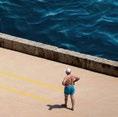
International Festival of urban photography promoted by Trieste dotART Association in media partnership with Photographers.it.
The Festival’s 6th edition will be attended by international special guests, such as British photographers Martin Parr and Nick Turpin, and will offer an array of exhibits, workshops, screenings, contests, portfolio readings, book presentations, gatherings, and other events hosted in multiple venues of the city of Trieste.
Info
apertura/opening: 22.10 – 10. 11 www.triestephotodays.com
Viaggio nella terra dell’oro
“Friuli Venezia Giulia –Viaggio nella terra dell’oro”: questo il titolo della mostra multimediale di Luigi Vitale: un importante lavoro di documentazione che diventa itinerario emozionale di immagini e storie con una quarantina di opere fotografiche e cinque documentari dedicati ad altrettanti artisti: Altieri, Zuccheri, Serse, Valentinuz e Celiberti. Un evento espositivo che diventa occasione per valorizzare e far conoscere le eccellenze del territorio presentando il Friuli Venezia Giulia con un rinnovato profilo iconografico
“Friuli Venezia Giulia – Viaggio nella terra dell’oro” [lit. A Journey across the Land of Gold]: this is the title of a multimedia exhibition by Luigi Vitale: an important work in terms of documentation that has been turned into an emotional itinerary through images and stories. It consists of about forty photographs and five documentaries dedicated to the following artists: Altieri, Zuccheri, Serse, Valentinuz and Celiberti. The display provides the opportunity to promote and let visitors appreciate the excellence of the territory presenting Friuli Venezia Giulia with a renewed iconographic profile.
Info
dove/where: Galleria espositiva del Consiglio
Regionale, piazza Oberdan
apertura/opening:
29.10 – 19.11
Disobbedisco. La Rivoluzione di d’Annunzio a Fiume
L'esposizione, a cura di Giordano Bruno Guerri, primo grande evento di un intenso programma di appuntamenti per celebrare il Centenario dell'Impresa fiumana guidata da Gabriele d'Annunzio nel biennio 1919-1920, racconta la Rivoluzione dannunziana attraverso gli oggetti e le parole dei protagonisti in una ricostruzione delle atmosfere e delle testimonianze di coloro che vi parteciparono.
Organised by Giordano Bruno Guerri, this exhibit is the first in a series of numerous events celebrating the 100th anniversary of Gabriele d’Annunzio’s Impresa di Fiume between 1919-1920. D’Annunzio’s revolution against the handing over of the city of Fiume, joined with adjacent Croatian territories after Paris Peace Conference in 1919, is told through the objects and words of those who were there a moving reconstruction of atmosphere and witnesses’ accounts.
Info
dove/where: Salone degli Incanti, riva Nazario Sauro, 1 apertura/opening: fino al 3.11 / until 3.11
apertura/opening: martedì–domenica 10–20, apertura straordinaria 1.11 / Tuesday–Sunday 10–20, exceptional opening on 1 .11 intero/full price € 6,00 ridotto/concession € 4,00 www.dannunzioatrieste.it
Il cinema in posa
La mostra, a cura di Claudia Colecchia, responsabile della Fototeca e della Biblioteca dei Civici Musei di Storia ed Arte, propone un percorso narrativo per vedere il cinema a Trieste, e non solo, dal Secondo Dopoguerra alla prima metà degli Anni Sessanta: una selezione delle sale ospitanti, dei film, degli attori, dei critici e dei registi, nonché dei consumatori, come documentati in Fototeca attraverso un itinerario indotto dai fotografi, veri protagonisti del percorso visivo e insostituibili compagni di viaggio.
Organised by Claudia Colecchia, manager of the Photographic Archive and Library of the Civici Musei di Storia ed Arte, this exhibit offers an itinerary focusing on the history of cinema in Trieste, starting from the aftermath of World War II to the first half of the Sixties: a selection of venues, films, actors, critics, directors, and, of course, viewers, as portrayed in the visual documents of the Fototeca, telling cinema’s history from the perspective of photographers, privileged observes and irreplaceable journey companions.
Info dove/where: Palazzo Gopcevich, via Rossini 4 apertura/opening:

fino al 13.10 / until 13.10; martedì–domenica 10–17 / Tuesday–Sunday 10–17, ingresso libero/free entrance www.fototecatrieste.it
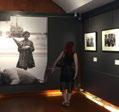
79 TRIESTE LIFESTYLE IES N°7 — September 2019 Agenda
Patti Smith in concerto

La “sacerdotessa” del rock” per la prima volta a Trieste per due date da non perdere al teatro Il Rossetti. Patti Smith salirà sul palco con Tony Shanahan alla chitarra e al pianoforte, portando il suo “Words and Music” a Trieste, città che ha affascinato l'artista per la sua cultura e storia e nella quale, per suo specifico desiderio, vorrà ripercorrere gli itinerari di Svevo, Rilke, Joyce, Saba.
High priestess of Rock Patti Smith’s not-to-be-missed show, for the first time in Trieste, for two consecutive nights at theatre Rossetti. The high priestess of Rock will be on stage accompanied by Tony Shanahan (guitar and keyboard) bringing her “Words and Music” to Trieste, a city that left her fascinated with its culture and history, and where she intends to follow the itineraries of Svevo, Rilke, Joyce, and Saba.
Info
dove/where:
Teatro il Rossetti
date/dates:
25.11 – 26.11
www.ilrossetti.it
Museo
Casa Mia
Musei civici visitabili gratis ogni prima domenica del mese: un’occasione da non perdere per scoprire l’immenso e variegato patrimonio museale dei musei del Comune di Trieste.
Free entrance to all City Museums [Musei Civici] every first Sunday of each month: do not miss this unique opportunity to visit Trieste’s huge and multifaceted cultural heritage.
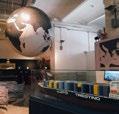

Info apertura/opening: 6.10, 3.11, 1.12
www.triestecultura.it
Deposito a vista
Sezione del museo del mare di Trieste dedicata al Lloyd, l’antica compagnia di navigazione austroungarica: un interessante percorso scandito dai colori dominanti delle navi, il nero, il rosso e il bianco, pensato come un deposito a vista e destinato a far conoscere la ricchezza del fondo, punto di partenza per ricerche e studi.
A section of Trieste’s sea museum entirely devoted to Lloyd, also known as Österreichischer Lloyd (Italian: Lloyd Austriaco, English: Austrian Lloyd), the largest Austro-Hungarian shipping company: a fascinating itinerary articulated according to Lloyd’s ships main colours, namely black, red, and white, in an open-air depot displaying the value of the foundation, starting point of countless research efforts.
Info dove/where: Magazzino 26, Porto Vecchio apertura/opening: venerdì, sabato, domenica e festivi 10–19/ Open Friday to Sunday and on Holidays 10–19 ingresso libero/free entrance
www.triestecultura.it
Trieste Science +Fiction Festival

19a edizione della principale manifestazione italiana dedicata ai mondi della fantascienza e del fantastico nelle produzioni di cinema, tv e new media; letteratura, comics. arti visive e dello spettacolo completano il quadro del programma.
Celebrating its 19th edition, Italy’s main event dedicated to science fiction and fantasy offers a wide array of productions, ranging from films, to TV and new media, literature, comics, visual arts, and shows.
Info apertura/opening: 29.10 – 3.11
www.sciencefictionfestival.org
80 TRIESTE LIFESTYLE IES N°7 — September 2019 Agenda
AGENDA
Traumhaft schön wohnen
Ihr neues Zuhause am Meer zu einem attraktiven Preis
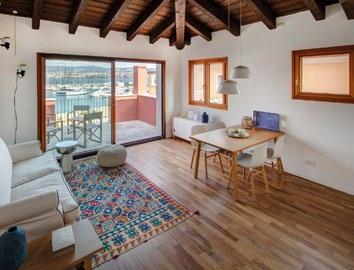
Ihr ganz persönliches Paradies an der Adria wartet schon! Komfortable und neu renovierte Domizile mit Blick auf den malerischen Hafen nahe des Küstenortes Muggia, Bars und Restaurants im Areal, Liegeplätze in der Marina, bester Service und tolle Events - das alles ist „Borgo San Rocco“. Sie wollen Ihrem neuen Appartement eine individuelle Note verleihen? Wir beraten Sie gerne! Unser Büro ist auch Samstag und Sonntag für Sie geöffnet.
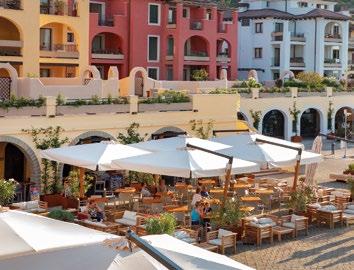

Zweizimmerwohnung ab 120.000 Euro

Öffnungszeiten Verkaufsbüro: Montag bis Sonntag von 9 bis 13 Uhr und von 14 bis 19 Uhr. Strada per il Lazzaretto, 2 - 34015 Muggia - Trieste - Tel. +39 040 0646840 - www.borgosanrocco.eu - info@borgosanrocco.eu


































 Italo Svevo
Italo Svevo






 Foto di /Photo by Marino Ierman
Foto di /Photo by Marino Ierman




 Adriano de Rota – Spettacolo di operetta nel Cortile delle Milizie, 1957
Adriano de Rota – Spettacolo di operetta nel Cortile delle Milizie, 1957



















 di /by
di Ilaria Romanzin
di /by
di Ilaria Romanzin



























































 Via San Sebastiano, 1 Trieste - T +39 040 632191
Via Caboto / angolo Via Malaspina, 1/1 Trieste - T +39 040 827431
c/o PORTOPICCOLO, Sistiana 231/Q9 T +39 040 9976625
Via San Sebastiano, 1 Trieste - T +39 040 632191
Via Caboto / angolo Via Malaspina, 1/1 Trieste - T +39 040 827431
c/o PORTOPICCOLO, Sistiana 231/Q9 T +39 040 9976625





























